“In lonely watches night by night
Great visions burst upon my sight,
For down the stretches of the sky
The hosts of dead go marching by.”
[Frederick George Scott, near Ypres, May 1915]
During the evening of Sunday 20th June the 1/6th Battn marched 8km to the north of Kemmel and billeted in huts on the Ouderdom to Vlamertinge Road, which was situated just to the west of Ypres. Three days later on Wednesday the 23rd June they relieved the 5th Durham Light Infantry in trenches to the east of Zillebeke on the edge of Sanctuary Wood, with support posts placed in Maple Copse and a reserve in Ouderdom.
In his personal diary Alfred Afford records that “D” Company took over trench number A5 at Hill 60. However Hill 60 lies 2km to the south of Sanctuary Wood, so he may have confused Hill 60 with another hill in this sector known as Hill 62 or “Tor Top”, which at this time was in British hands. Trench A5 was to the south of Sanctuary Wood between Hill 62 (Tor Top) and Hill 59 (Mt Sorrell.
Hill 59 was christened ‘Mountsorrel’ by the 1/5th Leicester’s at their arrival in the sector, after a village near Leicester, which was the home of their commanding officer.
For the next 2 months the 1/6th Battalion, alternating with 1/5th Battalion, would hold these trenches on the south-eastern edge of Sanctuary Wood.
In fact the 46th Division now found themselves occupying trenches at the very extreme edge of the British Salient, almost due east of Ypres and just to the south of the Menin Road. At this point of the front line the British trenches ran through a series of woods starting at Zouve Wood to the north and facing the village of Hooge on the Menin Road. To the east of this was Sanctuary Wood, which was the largest of these plantations that ran in a southwesterly direction to the east of Maple Copse. Finally, to the south of Sanctuary Wood there was Armagh Wood and a small copse know as Larch Wood, which was next to the Ypres to Commines Railway. At this point in the line were Hill 60 and the ‘dump’, which were located on opposite sides of the railway cutting. The 46th Division were responsible for the area of the salient between the Menin Road in the north and the Comines Railway in the south, a total frontage of over 3000 yards.
Trench Duty: 23rd to 29th June 1915
On the evening of the 23rd June the Battalion took over trenches east of Zillebeke from the 4th Yorkshire Regiment and the 5th Durham Light Infantry. During this 6-day trench duty the Battalion suffered Lieut. Idwal Davies wounded, 1 man killed and another 16 wounded (one of these fatally). However, there is very little detail recorded about the events of these 6 days.
The first man of the 1/6th Battalion to be killed in the Ypres sector was:-
- 3287 Pte. Tom Bennett of “D” Company who was killed on the 28th June. He now has no known grave and is commemorated on the Menin Gate Memorial; however, Tom was in fact buried in a small cemetery in Armagh Wood that was used for trench burials at that time. Unfortunately, in the later fighting of June 1916, many of these small cemeteries were destroyed and it is likely that Tom’s grave was lost at this time.
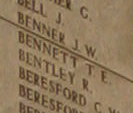
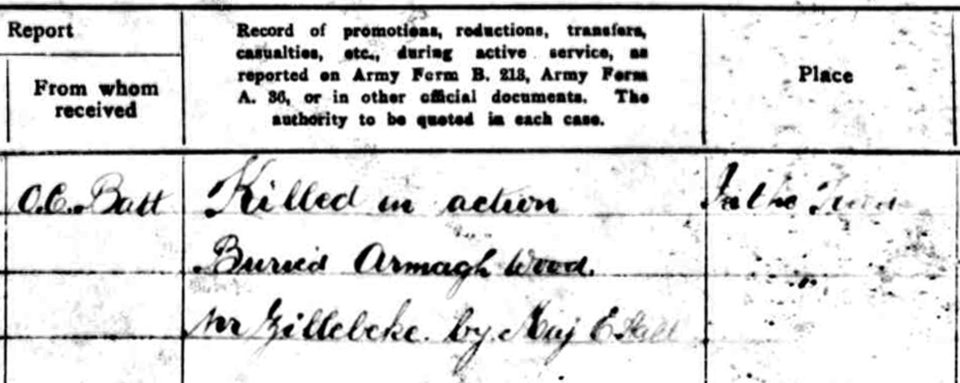 Army Form B103 (Casualty Form – Active Service) recording that Tom Bennett was killed in action in the field and buried in Armagh Wood near Zillebeke by Major Edward Hall.
Army Form B103 (Casualty Form – Active Service) recording that Tom Bennett was killed in action in the field and buried in Armagh Wood near Zillebeke by Major Edward Hall.
In fact during the 14 weeks that the 139th Sherwood Foresters Brigade spent in the Ypres sector seventy three men were killed in action and buried in small trench cemeteries in the surrounding woods, only for their graves to be lost by the end of the War.
Personal research undertaken using the Army service records of sissy seven of these men has identified the B103 Casualty Form of Tom Bennett as the only surviving written evidence that some of these graves were located in Armagh Wood.
The War Diary of the 1/7th Battalion recorded that 1671 Richard Thorpe and 1280 Frederick Wilson were buried in Sanctuary Wood and Maple Copse respectively. However, what is clear from these Army Service Records is that all the men were killed in action in the field and that their personal belongings were returned to the next of kin. Indeed, the father of 2739 Reginald Downham of the 1/8th Battalion wrote to the Commanding Officer thanking him for the letter stating where his son was buried.
See here for more information.
The men wounded during this trench duty were:-
- 2408 Sergt. John Keyworth wounded in the field on the 23rd June.
- 2718 Pte. Edgar Buckland wounded in the field on the 24th June.
- 3248 Pte. Sam Mason wounded in the field on the 25th June and returned to England. Later discharged due to wounds on 8th June 1916 (para 392 XVI).
- 1797 Pte. Harry Wilson who suffered a bomb wound in hand on the 25th June and was admitted to 1st NMFA and 5 General Hospital. Transferred to NM Base Depot on 5th July and rejoined Battalion on the 30th July.

- 1565 Pte. Squire Buckely Liddiard who suffered a GS wound to the head and was admitted to 1st NMFA and 3 CCS. He died from his wounds on 29th June and was buried in the cemetery at Bailleul.


- 1579 Pte. Patrick Fox suffered conjunctivitis and admitted to 2 CCS and 4 General Hospital. He re-joined Battalion on 30.7.15.
- 2360 Pte. Jacob Brooks was transferred to England due to injuries received in June 1915 when a dugout collapsed on him. Discharged 16.7.17 (para 392 XVI KR).
- 1944 Pte. Leonard Wilson suffered a bomb wound in hand and transferred to England on 29.6.15. Returned to France on 4.3.16 with the 6th Reinforcement.
- 1950 Sergt. William Rowe was wounded in the field.
- 1941 Pte. William Ryder suffered scabies and admitted to 6 General Hospital. Transferred to NMD base Depot on 6.8.15 and re-joined battalion on 7.10.15.
- 2149 Pte. Bernard Taylor suffered a GS wound in the shoulder and admitted to the 1st NMFA and 4 General Hospital. Transferred to NMD Base Depot on 6.7.15 and re-joined the Battalion on 30.7.15.
- 2675 Pte. Morgan Walters suffered myalgia and admitted to 1st NMFA and 4 General Hospital. Transferred to 46th NMD Base Depot on 10.7.15 and returned to the Battalion on 30.7.15.
- 400 Pte. Thomas Frith suffered a GSW in left knee and transferred to England on 4.7.15. Discharged 4.10.17.
- 816 Pte. William Burrows was wounded in the field.
- 1723 Pte. John Booker was wounded in the field.
- 1980 Pte. Thomas Eyre was wounded in the field and transferred to England. Discharged due to wounds on 29.12.15 (para 392 XVI KR).
- 2098 Pte. Ernest Askey was wounded in the field.
- 2132 Pte. Donald Barber was wounded in the field and transferred to England. Discharged due to sickness on 12.5.16 (para 392 XVI KR).

- 2672 Pte. Israel Cox was wounded in the field and transferred to England. Discharged due to wounds on 26.5.16 (para 392 XVI KR).
- 2531 Pte. Samuel Oakley was wounded in the field.
- 2945 Pte. John Wain suffered a GSW back and transferred to England.
Divisional Reserve: 29th June to 11th July
 On June 29th the 1/6th Battalion was relieved by the 5th Leicester’s and marched 16 miles to their billets in Poperhinge, north-east of Ypres.
On June 29th the 1/6th Battalion was relieved by the 5th Leicester’s and marched 16 miles to their billets in Poperhinge, north-east of Ypres.
Whilst in reserve at Poperhinge, and after four months in Flanders, the Battalion finally received its first draft of much needed reinforcements. Lieutenant John Symonds and 96 other ranks arrived from the entrenching battalion at the Base Depot and were quickly assigned to Companies.
The men that comprised this draft had arrived in France on the 25th & 28th June with the ‘I’ and ‘II’ Reinforcements respectively. The men had disembarked at Rouen and were initially sent to the 46th North Midland Base Depot. Interestingly, not all of the men that arrived in France with these drafts immediately joined the battalion ‘in the field’; a group of men were posted to the No 2 Entrenching Battalion and did not join the 1/6th Battalion until much later in the summer.
Men reporting sick during this period included:-
| 1755 | Pte | Sam Drabble | 29.6.15 | Pyrexia and admitted to 1st NFMA. Transferred to 46 DRS and returned to battalion on 1.7.15. |
| 2048 | Pte | George Fox | 29.6.15 | Pyrexia and admitted to 1st NFMA. Returned to Battalion on 0.7.15. |
| 1658 | Pte | William Booth | 29.6.16 | Inflammation of the joints and admitted to 1st NMFA and 4 General Hospital. Transferred to England on 2.7.15 and returned to France on 4.3.16 with 6th Reinforcement. |
| 1450 | Pte | Charles Woolley | 2.7.15 | Influenza and admitted to 46 DRS. Re-joined Battalion on 8.7.15. |
| 1559 | Pte | Fred Garlick | 3.7.15 | Pyrexia and admitted to 1st NMFA, 24 General and 14 Stationary Hospitals. Transferred to England on 16.8.15. Returned to France on 3.7.16 with the 13th Reinforcement. |
| 1805 | Pte | Walter Evans | 3.7.15 | Contracted influenza and admitted to 1st NMFA, 10 CCS and 24 General Hospital. Transferred to NMD Base depot and re-joined Battalion on 7.10.15. |
| 508 | Pte | Albert Askey | 3.7.15 | German measles and admitted to 1st NMFA and Fever Hospital. Rejoined unit on 23.7.15. |
At this time the Battalion continued to provide fatigue parties for work in the salient to the east of Ypres.
On 4th July a routine fatigue party 200 strong and under the command of Captain Edgar Heathcote marched to the front line, but came under heavy shellfire on the return journey:-
“On the Saturday night we went up to the lines on fatigue, and travelled up a long way in motor lorries; it was quite an exciting journey for us after we left the lorries to march through Ypres, especially as for many of us it was the first experience of the war. Fritz was sending over a few gas shells and we were all sneezing and rubbing our eyes. We drew spades and set off after a short rest, landed at the work, finished off fairly quickly and started for home – home consisting of bivvies made from water-proof sheets, and some of us hadn’t even got those. We had a pretty rough journey coming through Ypres, had just downed tools and started the march towards the houses, when Fritz began shelling; of course he managed to get a lucky shot right in the middle of us, killing and wounding about half the party, many of whom had not yet even seen the trenches”.
[Battalion History]
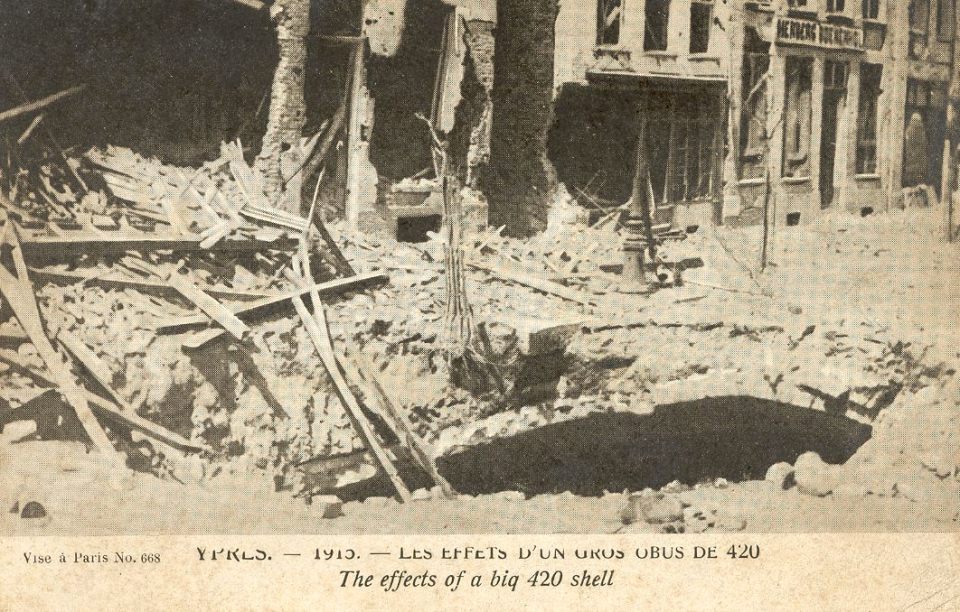 The casualties numbered thirty-two; nine men were killed or died of their wounds and another 23 were wounded. Although badly wounded himself 2377 Sergeant Godfrey Knowles from Matlock assisted with the care of the wounded.
The casualties numbered thirty-two; nine men were killed or died of their wounds and another 23 were wounded. Although badly wounded himself 2377 Sergeant Godfrey Knowles from Matlock assisted with the care of the wounded.
Godfrey ‘Gus’ Knowles was later granted a Captain’s Commission in the Royal Engineers. He was well known in the Matlock area and prior to the war he held a responsible position on the Midland Railway. He resided with his wife and family at Enslin Villas, Matlock Bath. He was badly wounded in the leg by a piece of shell during the shell explosion in Ypres. He was considered a ‘crack shot’ and was a member of the local Rifle Club [High Peak News, Saturday, July 17, 1915].
The July 10th issue of the Derbyshire Times reported that 6 men were killed and 24 wounded, mainly from Chapel-en-le-frith and the surrounding district:-
The nine men killed that early July morning were:-
- 2030 Pte. Richard Evans.
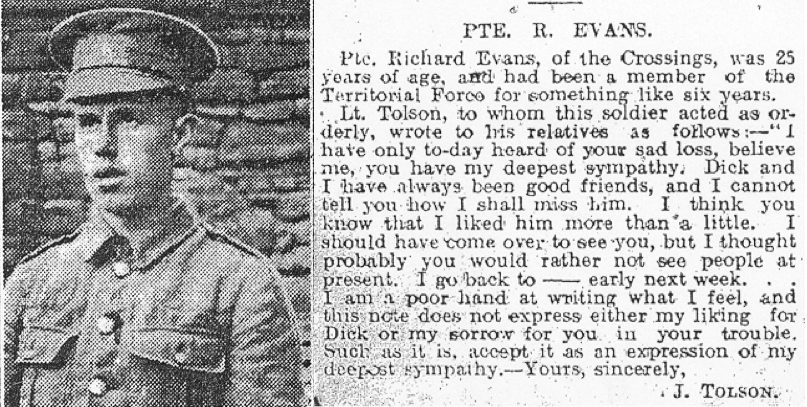
- 2284 Pte. Joseph Ford.

- 2290 Pte. James Greatorex.

- 1321 Pte. Percy Heather.

- 3224 Pte. George William Lomas

- 1322 Pte. Samuel Turner.
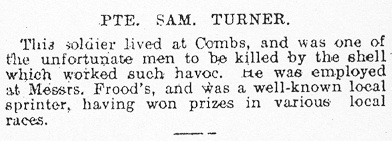
- 3117 Pte. Horace Lowe. Shortly before his death Horace had written to his mother (letter dated 1st July 1915) asking her for a package of ‘home comforts’.

“My dear mother, – will you please send me a parcel of tea and sugar. We are quite all right if we had a little more. I will write you as fast as I can. We are going into the trenches shortly . . . . We are in sound of the guns now. This is nice country but I would sooner have our own . . . . God be with you until we meet again. – Your loving son Horace”
[Letter published in High Peak News, Saturday, July 17th 1915]
- 2655 Pte. John Moss from Chesterfield.
- 2213 Pte. George Markham from Gainsborough later died of his wounds.

The men were not all buried together, and whilst six are buried in Bedford House Cemetery, which was the site of the 43rd Field Ambulance, another two are buried in Lijssenthoek, which was the site of the 10th Casualty Clearing Stations.
Bedford House Cemetery

 Bedford House Cemetery No 2. Many of the men that were buried in this plot (IV) were members of the Sherwood Foresters. The men that were killed on July 10th lie next to each other in Graves B59 to B65.
Bedford House Cemetery No 2. Many of the men that were buried in this plot (IV) were members of the Sherwood Foresters. The men that were killed on July 10th lie next to each other in Graves B59 to B65.
Bedford House, sometimes known as Woodcote House, were the names given by the Army to the Chateau Rosendal, a country house in a small wooded park with moats. Although it never fell into German hands, the house and the trees were gradually destroyed by shell fire. It was used by field ambulances and as the headquarters of brigades and other fighting units. ENCLOSURE NO. 2 was begun in December 1915 and used until October 1918
Lijssenthoek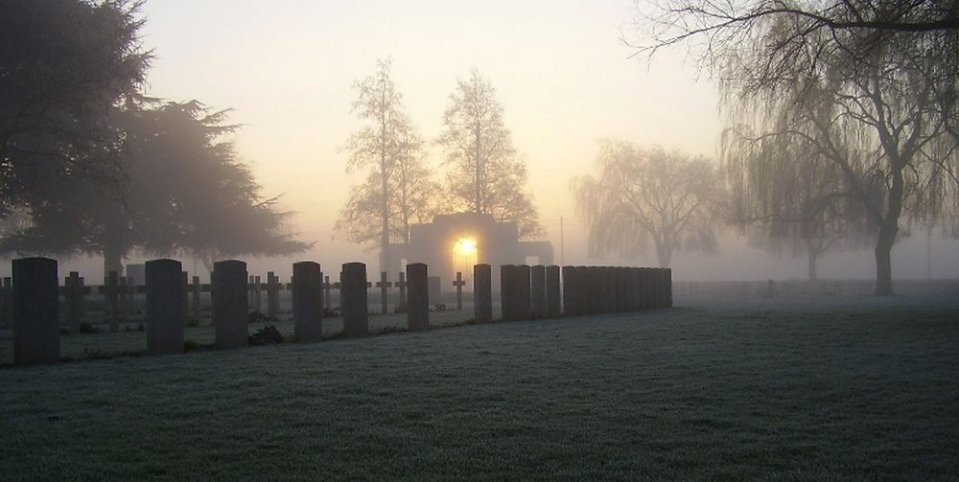
During WW1 the village of Lijssenthoek was situated on the main communication line between the Allied military bases in the rear and the Ypres battlefields. Close to the Front, but out of the extreme range of most German field artillery, it became a natural place to establish casualty clearing stations.
 Picture taken of “Remy” Cemetery shortly after the Armistice; the wooden grave markers have not yet been replaced by the marble CGWC headstones.
Picture taken of “Remy” Cemetery shortly after the Armistice; the wooden grave markers have not yet been replaced by the marble CGWC headstones.
War Dairy of the 10th Casualty Clearing Station recording the burial of 1522 Pte. Samuel Turner and 3224 George Lomas.
 1522 Pte. Samuel Turner and 3224 George Lomas are buried next to each other in plot III D graves 6A and 7.
1522 Pte. Samuel Turner and 3224 George Lomas are buried next to each other in plot III D graves 6A and 7.  Part of the Army Service Record of George Lomas recording his burial at L.22.d.6.3. by Archdeacon Southwell.
Part of the Army Service Record of George Lomas recording his burial at L.22.d.6.3. by Archdeacon Southwell.
 Location of the 10th Casualty Clearing Station at Corfu Farm, which was later to known as Remy Siding.
Location of the 10th Casualty Clearing Station at Corfu Farm, which was later to known as Remy Siding.
 Corfu Farm in 2012. The large barn was used by the Casualty Clearing Stations to treat the wounded.
Corfu Farm in 2012. The large barn was used by the Casualty Clearing Stations to treat the wounded.
Record of the casualties admitted to the 10th Casualty Clearing Station in July 1915. Information taken from the War Diary. A full list of men the buried in July 1915 can be seen here Lijssenthoek July 1915.
The men wounded by the shell included:-
| 2720 | Pte | Fred Smith | 4.7.15 | GSW left arm and returned to duty. |
| 1429 | Pte | Percy Williams | 4.7.15 | Wounded in the field. |
| 1545 | Pte | J Newton | 4.7.15 | Wounded in the field. |
| 1564 | L/Cpl | Samuel Hyde | 4.7.15 | Wounded in the field. |
| 1689 | Pte | Frank Morgan | 4.7.15 | GSW in buttock and returned to Battalion. |
| 1697 | Pte | Willie Hodkin | 4.7.15 | Shrapnel wound in right knee and admitted to 10 CCS, 2 Canadian Stationary Hospital and Base Detail Camp. Transferred to No. 2 Entrenching Battalion on 16.8.15 and re-joined Battalion on 16.10.15. |
| 1721 | Pte | Bertie Longson | 4.7.15 | Both legs amputated and transferred to England. Discharged due to wounds on 24.6.15 (para 392 XVI KR). |
| 1948 | Pte | Frank Rowbottom | 4.7.15 | Wounded in the field. |
| 2074 | Pte | George Favell | 4.7.15 | GSW in buttock and admitted to 1st NMFA, 10 CCS and 2 Canadian Stationary Hospital. Transferred to NMD Base Depot on 23.7.15 and returned to Battalion on 30.7.15. |
| 2190 | Pte | Walter Lamb | 4.7.15 | Wounded in field and transferred to England. Discharged due to wounds on 3.5.15 (para 392 XVI KR). |
| 2377 | Sergt | Geoffrey Knowles | 4.7.15 | Wounded in the field. |
| 2567 | Pte | Isaac Boden | 4.7.15 | Wounded in the field. |
| 2693 | Pte | George Kimberley | 4.7.15 | Wounded in the field. |
| 2943 | Pte | William Lyons | 4.7.15 | Wounded in the field. |
| 3155 | Pte | Richard Marshall | 4.7.15 | Wounded in the field. |
| 3225 | Pte | Joseph Hassel | 4.7.15 | Wounded in the field. |
| 3367 | L/Cpl | Walter Watson | 4.7.15 | Wounded in the field. |
Pte Bert Longson aged 20 had both his legs amputated below the knees. His brother 1464 Corporal W also served with the 6th Battalion Sherwood Foresters. The High Peak News (July 24th) recorded the arrival home on leave of Corporal W Longson. He was reported to still have the mud of Flanders on his boots and cothes as he arrived at the train station.
During this rest period the Battalion were able to organise an inter Company cricket match between platoons of “B” Company and involving many local sportsman from the Chapel and Whaley Bridge areas.
For number 5 platoon 393 Pte Joel Frith opened the batting and scored a magnificent 46, reminding many of the men of his stoke play in the ‘old days’ in Derbyshire. To complete the victory for the 5th Platoon 2297 Pte Samuel Heyworth bowled 7 overs and took 6 wickets for 9 runs including 5 maidens.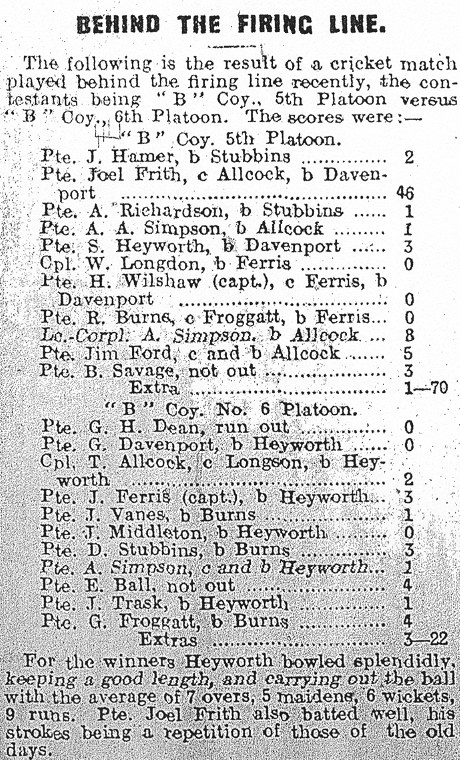
Of the 22 men who played in the cricket game on that warm July afternoon, ten were to lose their lives before the end of the War; three of these before the end of 1915.
The report of this cricket match ‘Behind the firing lines’ appeared in the July 15th edition of High Peak News
Even in reserve there was a steady stream of casualties for the field ambulance and casualty clearing stations. Amongst them was:-
- 1410 L/Cpl Pete White a miner at Alma Colliery in Clay Cross was wounded by shrapnel in the abdomen. He transferred to the 3rd British Red Cross Hospital, but died of blood poisoning nearly 6-weeks later and was buried in Abbeville. Picture courtesy of Peter Hoben.

- Privates 2475 Fred Holmes and 1398 William Glover were much luckier and were transferred to England where they recovered from their wounds.
2475 Pte Fred Holmes 7.7.15 Wounded in the field and transferred to England on 7.7.15. Returned to France on 10.11.15 with V Reinforcement. 1398 Pte William Glover 9.7.15 Wounded in the field and transferred to England on 9.7.15. Returned to France on 10.11.15 with V Reinforcement.
Men reporting sick included:-
| 1778 | Pte | Harry Hampson | 5.7.15 | Measles and admitted to 1st NMFA. Re-joined Battalion on 9.7.15. |
| 1928 | Pte | Harold Towndrow | 5.7.15 | Influenza and admitted to 10 CCS and 20 General Hospital. Transferred to England on 30.7.15. Returned to France on 4.3.16 with the 6th Reinforcement. |
On July 11th the Battalion moved to the Maple Copse area and two Companies occupied trenches A6 to A9 whilst two Companies remained in support just behind the front line. The 1/6th Battalion remained in and around Maple Copse until the 22nd July.
 On the 12th of July Private 1563 Harry Depledge of No 7 Platoon “B” Company was killed at duty and buried in Maple Copse Cemetery by Colonel Goodman. He was the first man of the 1/6th to be buried in this little copse, however, after the War his grave was lost, like that of 6 of his comrades and all of them are now commemorated on a special memorial with the grounds of the new cemetery.
On the 12th of July Private 1563 Harry Depledge of No 7 Platoon “B” Company was killed at duty and buried in Maple Copse Cemetery by Colonel Goodman. He was the first man of the 1/6th to be buried in this little copse, however, after the War his grave was lost, like that of 6 of his comrades and all of them are now commemorated on a special memorial with the grounds of the new cemetery. Sergeant 1380 Harry Jackson of No 7 Platoon, B Company, later wrote to Harry’s family to convey the sad tidings:-
Sergeant 1380 Harry Jackson of No 7 Platoon, B Company, later wrote to Harry’s family to convey the sad tidings:-
“You will no doubt have heard the sad news of your son Harry’s death. I am writing on behalf of all his comrades in No. 7 Platoon. He was cheerful and will be sadly missed by all his comrades. Many times he has kept us all smiling with his ready wit and humour, and his death has cast a gloom over all of us”
[Letter published in High Peak News, Saturday, July 24th 1915]
On Sunday 18th July the Battalion handed over the front line trenches and moved into reserve; 2 Companies (“B” and “D”) garrisoned reserve trenches R4, R5 and R6 in Sanctuary Wood, whilst “A” and “C” Companies remained behind the front line trenches in Maple Copse.
At 7pm on the 19th July the Hooge mine was exploded, leaving a crater that had a lip 15 feet above ground level, 120 feet wide and 20 feet deep.
However, even in reserve positions the Battalion were forever on the alert and stood to arms on the 20th July expecting a German attack that never materialised.
By the 22nd July the Battalion had suffered 3 men killed and 19 wounded. The men killed after Harry Depledge were:-
- 2142 Bugler Frank Hallam from Buxton.
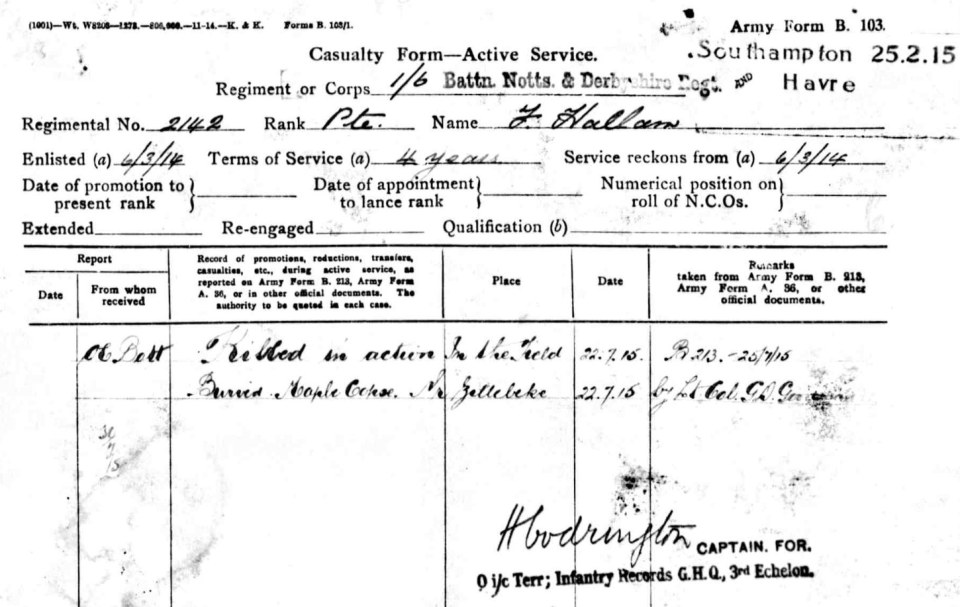
- 1301 Pte. Alfred Gent from Chesterfield.

- 2859 Pte Harold Buxton, a moulder from new Tupton, was fataly wounded by a gun shot wound in the neck. He was tansfered from the 1st NMFA to the 12th CCS and eventully the 13th Stationary Hospital at Boulogne. However he succumed to his wounds nine days later at 5.20 am on the 28th December. He was buried in grave ‘2586’ in the soldiers cemetery.

Amongst the less seriously wounded were:-
|
2828 |
Pte | Napier Mills | 12.7.15 | Wounded in the field. |
| 2047 | Pte | Thomas Salt | 13.7.15 | GSW in left thigh. Admitted to 1st NMFA, 1 SMD CCS and 3 General Hospital. Returned to England on 18.7.16 and discharged on 3.6.15 (para 392 XVI KR). |
| 1777 | Pte | Thomas Chatterton | 14.7.15 | GS wound in the head and admitted to 1st NMFA, 50 CCS and 2 General Hospital. Re-joined Battalion on 30.7.15. |
| 1345 | Pte | Albert Etherington | 15.7.15 | Wounded in the field and transferred to England. Returned to France on 13.5.16 with the 9th Reinforcement. |
| 11 | Pte | John Taylor | 16.7.15 | GS wound in shoulder and transferred to England on 16.7.15. Discharged on 26.5.16 (para 392 XVI KR). |
| 1434 | Pte | Fred Chell | 16.7.15 | GSW in cheek and returned to battalion. |
| 2879 | Pte | Richard Milnes | 16.7.15 | GSW in right shoulder. Admitted to 1st NMFA and 46 DRS. Returned to duty on 20.7.15. |
| 3034 | Pte | John Wright | 16.7.15 | Wounded in the field. |
| 3075 | Pte | George Toplis | 16.7.15 | Wounded in the field. |
| 2183 | Pte | William Barker | 16.7.15 | GS wound in right arm. |
| 299 |
Pte |
William Turner | 18.7.15 | Dispatched to England on the SS St Petersburg for home station and discharged 12.5.16. |
| 1763 | Pte | George Weatherley | 18.7.15 | Wounded in the field. |
| 1002 | Pte | Herbert Schofield | 19.7.15 | Bullet wound in the abdomen and admitted to 1st NMFA, 40 CCS and 8 General Hospital. Transferred to England on 21.7.15 and discharged (Para 392 XVI of KR). |
| 1594 | Pte | James Hughes | 19.7.15 | Wounded in the field*. |
| 2234 | Sgt | James Needham | 19.7.15 | GSW right thigh and admitted to 1st NMFA, 5 CCS and 13Stationary Hospital. Transferred to England on 23.5.15. Returned to France in 1917. |
| 1543 | Pte | Harry Jodrell | 20.7.15 | GSW in left arm and transferred to England on 29.7.15. Discharged due to wounds on 9.5.16 (para 392 XVI KR). |
| 1499 | Pte | Charles Potter | 20.7.15 | GS wound in abdomen. Admitted to 1st NMFA and 50 CCS. Transferred to England on 27.7.15. Returned to France on 10.11.15 with V Reinforcement. |
| 20 | Pte | George Gratton | 21.7.15 |
Wounded in the field and transferred to England. Discharged due to wounds on 17.7.16 (para 392 XVI KR). |

 On Friday 23rd July the Battalion returned to Sanctuary Wood and took over trenches A8-A12 and B1-B2 from the 1/5th Battaion and there they remained until the 27th July.
On Friday 23rd July the Battalion returned to Sanctuary Wood and took over trenches A8-A12 and B1-B2 from the 1/5th Battaion and there they remained until the 27th July.
During their time in the front line trenches the Battalions of the 139th Brigade continued a practice of patrolling the wire and advanced listening posts. The Germans in this sector were very active and often dug new fire trenches or advanced posts. The front line trenches in this sector were very close, often only several yards apart, and it was important to maintain the upper hand in this sector. Indeed the War History of the 5th Battalion Sherwood Foresters describes an incident in which opposing machine gun points were only 3 yards away. The Germans only occupied their post during the evening and it soon became a point of honour for the Sherwood Foresters to visit the post before it was occupied and remove any available souvenirs. Becoming wise to this the German’s began to conceal booby traps in interesting booty, however by setting their own bombs the Foresters scored first.
[War History 5th Battalion Sherwood Foresters]
As the 1/6th Battalion continued to hold the front line in and around Santuary Wood they suffered a continous stream of trench casualties who were buried either just behind the firing line in Maple Copse, which was the site of an advanced dressing station and became the primary cemetery for Sherwood Foresters trench burials.
During this trench duty three men were killed in action:-
- 2980 William Eyre a miner from North Wingfield
- 1575 William Cartledge a quarryman from Monsal Dale.
- 894 Arthur Read a hydro assistant from Matlock who was killed a shell bursting in the trench.
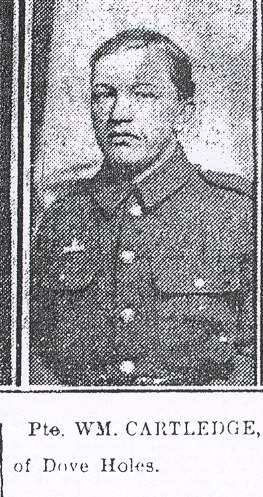
 Privates Eyre and Read were both buried in Maple Copse in a service conducted by by Colonel Goodman, whilst William Cartledge was buried in Divisional Cemetery and he is the only man of the entire 139th Sherwood Foresters Brigade to be laid to rest there. The cemetery is sitated on the Western edge of Ypres and was used for burials from April 1915 onwards. It’s possible that William was buried in this Cemetary as the Battalion was marching back to their bivouacs, which were located between Poperinge and Vlamertinge at G.18.C.2.8.
Privates Eyre and Read were both buried in Maple Copse in a service conducted by by Colonel Goodman, whilst William Cartledge was buried in Divisional Cemetery and he is the only man of the entire 139th Sherwood Foresters Brigade to be laid to rest there. The cemetery is sitated on the Western edge of Ypres and was used for burials from April 1915 onwards. It’s possible that William was buried in this Cemetary as the Battalion was marching back to their bivouacs, which were located between Poperinge and Vlamertinge at G.18.C.2.8.
During this trench duty the Battalion also suffered 12 men wounded (2 of whom later died).
The sick and wounded men included:-
| 2047 | Pte | Thomas Salt | 13.7.15 | GSW in left thigh. Admitted to 1st NMFA, 1 SMD CCS and 3 General Hospital. Returned to England on 18.7.16 and discharged on 3.6.15 (para 392 XVI KR). |
| 1777 | Pte | Thomas Chatterton | 14.7.15 | GS wound in the head and admitted to 1st NMFA, 50 CCS and 2 General Hospital. Re-joined Battalion on 30.7.15. |
| 1345 | Pte | Albert Etherington | 15.7.15 | Wounded in the field and transferred to England. Returned to France on 13.5.16 with the 9th Reinforcement. |
| 11 | Pte | John Taylor | 16.7.15 | GS wound in shoulder and transferred to England on 16.7.15. Discharged on 26.5.16 (para 392 XVI KR). |
| 1434 | Pte | Fred Chell | 16.7.15 | GSW in cheek and returned to battalion. |
| 2879 | Pte | Richard Milnes | 16.7.15 | GSW in right shoulder. Admitted to 1st NMFA and 46 DRS. Returned to duty on 20.7.15. |
| 3034 | Pte | John Wright | 16.7.15 | Wounded in the field. |
| 3075 | Pte | George Toplis | 16.7.15 | Wounded in the field. |
| 2183 | Pte | William Barker | 16.7.15 | GS wound in right arm. |
| 299 | Pte | William Turner | 18.7.15 | Dispatched to England on the SS St Petersburg for home station and discharged 12.5.16. |
| 1763 | Pte | George Weatherley | 18.7.15 | Wounded in the field. |
| 1002 | Pte | Herbert Schofield | 19.7.15 | Bullet wound in the abdomen and admitted to 1st NMFA, 40 CCS and 8 General Hospital. Transferred to England on 21.7.15 and discharged (Para 392 XVI of KR). |
| 1594 | Pte | James Hughes | 19.7.15 | Wounded in the field. |
| 2234 | Sgt | James Needham | 19.7.15 | GSW right thigh and admitted to 1st NMFA, 5 CCS and 13 Stationary Hospital. Transferred to England on 23.5.15. Returned to France in 1917. |
| 1543 | Pte | Harry Jodrell | 20.7.15 | GSW in left arm and transferred to England on 29.7.15. Discharged due to wounds on 9.5.16 (para 392 XVI KR). |
| 1499 | Pte | Charles Potter | 20.7.15 | GS wound in abdomen. Admitted to 1st NMFA and 50 CCS. Transferred to England on 27.7.15. Returned to France on 10.11.15 with V Reinforcement. |
| 20 | Pte | George Gratton | 21.7.15 | Wounded in the field and transferred to England. Discharged due to wounds on 17.7.16 (para 392 XVI KR). |
| 1282 | Pte | William Taylor | 23.7.15 | Myalgia and admitted to 46 DRS. Re-joined Battalion on 28.8.15. |
The weather at this time was warm and it soon became clear that the supply of water to the front line troops was of paramount importance and during each night fresh water was brought up by cart to the Brigade water dump in Sanctuary Wood. However water was still scarce and the men were ordered not to shave in the trenches and if caught they face disciplinary action. During these few days in bivouacs several men ‘returned to duty’ from the Divisional rest station after bieng sikc or wounded eariler in the year.
At this time a Brigade sniping section was formed, which comprised the crack shots from all four Sherwood Foresters Battalions and were issued with rifles that were equipped with telescopic sites. The section were particularly active and each man was responsible for finding his own ‘sniping spot’. Once the sniper had claimed his victim he would withdraw from the position leaving the trench garrision to suffer the inevitable German retaliation of grendes and artillery fire.
Parody on “MY LITTLE GREY HOME IN THE WEST”
by
991 Sergeant William Roberts
In the trenches (well) not far from Ypres,
Where bog shells give you the creeps,
Some go whiz bang, but we don’t care a bang,
So long as we get home for keeps.
The day will soon come so they say,
When this din will all pass away
Then the tales we will tell
Of the day here in hell,
In the trenches (well) not far from Ypres.
In the trenches (well) not far from Ypres,
Where gas thro’ into the atmosphere creeps,
These demons of hell, by this chocking smell,
Brave lads have put to their sleep.
But wait till we get at them fair,
With our toothpicks we will part their hair,
In a new-fashioned style, and it won’t make them smile,
In the trenches (well) not far from Ypres.
In the trenches (well) not far from Ypres,
Peak lads now their faithful watch keep,
When their bayonets are fixed,
The Huns will find that the Sixth,
Are the boys for to make them retreat.
So all you young men now at home,
Don Khaki, and leave sport alone,
And gives us a hand, to clear this German band,
In the trenches (well) not far from Ypres
——————————————————————
“THE 6TH SHERWOODS”
We’re not far from Ypres they say,
Where we lads keep the Germans at bay;
So Wilheme, Der grosse, he darn’t come across,
‘Cos the Sherwoods keep looking that way.
At night we’re on the alert,
With our “rounds” we make something “spurt”,
We cannot see much, but we just keep in touch,
Till a light goes up with a flirt.
At present we are M.I.,
With a sergeant, who is a good mon,
There’s Sul, Kell, and Mo, Jod, Knowles and Gibo,
We all stand together as one.
We’re not very far from the Huns,
But I don’t think they get many buns;
We get our bread and a few rounds of ?ad,
And a shelf which holds a few “Buns”.
—– is just on our left,
Were thousands have gone to their death;
The Germans used gas are men couldn’t pass,
Which stopped them from getting their bread.
—– is just on our right,
Where we show them the way;
They have used gas here without any fear,
But we’ve got a conclusion that right.
I’m one of the boys from the Peak,
There’s another at present asleep;
But while I am here, he’s no need to fear,
The Germans darn’t offer to creep.
There’s four who come from one town,
But the men they never look down.
They look straight in front and they never grunt,
‘Tis true they look a bit brown.
The sergeant, who’s name is Bee,
He’s a jolly good chat you will see;
At every stand-to he’s out with us few,
Then after we start making tea.
For we’re all Sherwoods ‘tis said,
We’ed sooner have khaki than red;
There’s a good many more, darn’t look down the bore,
They’re frightened of leaving their bed.
So young men of Derbyshire bold,
Who have never yet been under fire,
Just come out here, you’ve no need to fear,
There’s plenty of lead and barbed wire.
So friends I will draw to a close,
For there’s a good many who knows?
Who have been out here, and had on the gear,
They’ll teel you the way things go.
“M.S.,” 6th S. Foresters
[High Peak News, Saturday 3rd July 1915]
Action at Hooge
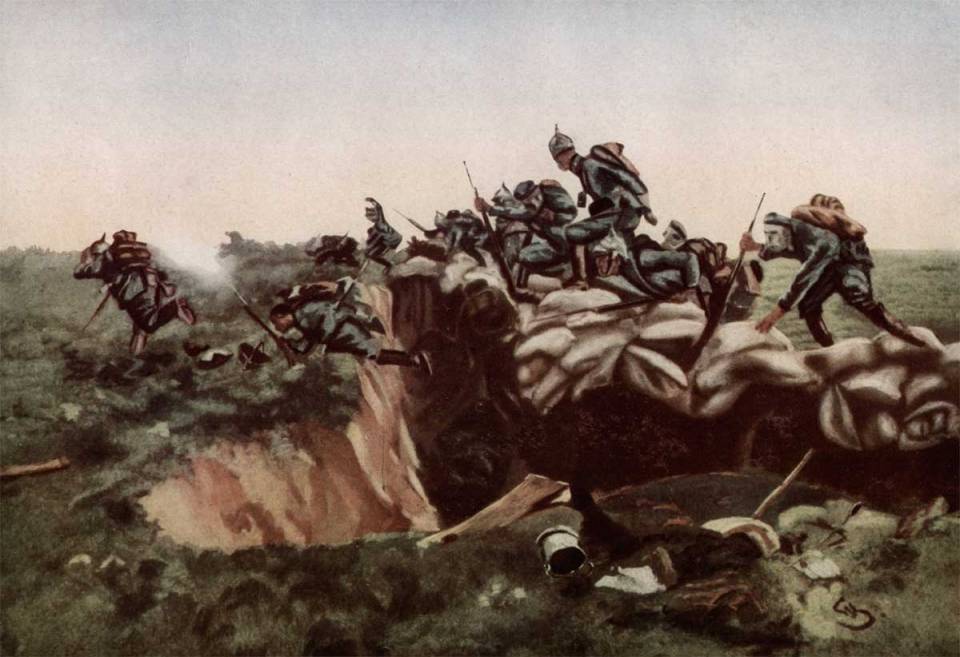 During the early morning of Saturday July 31st the Germans launched an attack on the trenches opposite Hooge using ‘flammenworfer’ for the first time. The attack initially fell on the ?? Kings Royal Rifle Corp, but soon spread to involve the 8/Sherwood Foresters and “B” Company of the 5/Sherwood Foresters. All too quickly the Germans broke through the line held by the ?/KRR and the Sherwood Foresters were soon in danger of being surrounded. The 5/Sherwood Foresters quickly dug a new trench at right angles to their front line and moved a machine gun up to a clearing in Santuary Wood.
During the early morning of Saturday July 31st the Germans launched an attack on the trenches opposite Hooge using ‘flammenworfer’ for the first time. The attack initially fell on the ?? Kings Royal Rifle Corp, but soon spread to involve the 8/Sherwood Foresters and “B” Company of the 5/Sherwood Foresters. All too quickly the Germans broke through the line held by the ?/KRR and the Sherwood Foresters were soon in danger of being surrounded. The 5/Sherwood Foresters quickly dug a new trench at right angles to their front line and moved a machine gun up to a clearing in Santuary Wood.
The Germans had managed to capture the British front line and communication trenches parallel to the Ypres-Menin Road and were soon seen consolidating these gains in preparation for a further attack. In order to delay this attack and allow time for the British to prepare a counter attack the Sherwood Forester’s machine gunners keep up a steady fire all day. The ?/KRR were quickly ordered back from their billets and at once undertook a counter-attack. Planned quickly for 2pm this attack was supported by artillery firing to a “yard” and eight machine guns of the 5/Sherwood Foresters.
The 8th Sherwood Foresters had created a double block towards Hooge and this was a scene of continious bombing attacks involving grenadiers from both the 7th and 8th Sherwood Foresters as they attempted to push up Zouave Communication trench. During this time the 7/Sherwood Foresters had arrived from Maple Copse and commenced to dig new support trenches from Zouave Wood.
At 2.00am the following morning the Germans again attacked with ‘liquid fire’, however this time the defenders were ready and immediately began to concentrate machine gun and artillery fire on the German positions. This prevented an attack for the time being but it was clear the British were now in a critical position.
During the evening of Tuesday 3rd August the 1/6th Battalion moved into Brigade support in Maple Copse; “B” Company was in support of the 8/Sherwood Foresters in Sanctuary Wood. Two days later the 2nd Sherwood Foresters of the 6th Division relieved the 6th Battalion in Maple Copse and then moved on to replace the 5th Battalion in the front line trenches overlooking the new German position near Hooge. The High Command of the Second Army had decided that a carefully planned attack involving tried and tested regular soldiers was required to restore the line at Hooge. The 6th Division had been relieved of front line duties on August 2nd and 3rd and had marched to Poperinge, where they went into billets close to the railway line. Early in the afternoon of 6th August the 6th Division was in place for the attack and the preparatory bombardment started. The 18th Brigade was given the task of securing the high ground north of the crater at Hooge. To deceive the enemy as to the intended point of attack a number of diversions were planned by the 46th and 49th Divisions. The 46th Division, immediately to the south of the 6th Division attacked Hill 60, whilst the 49th Division attacked Pilckem Ridge to the North. During the attack of the 6th Division, the 18th Brigade led the assault with companies from ?? and ??, whilst the 2/Sherwood Foresters remained in support. The 139th Brigade of the 46th Division occupied the left of their allotted sector and was therefore on the right of the 18th Brigade. The disposition of the front line Battalions was therefore 2nd Battalion, 1/8th Battalion and 1/7th Battalion, with the 1/6th Battalion (trenches A8-12 and B1-B2; company order A, B, C, D; Battalion HQ was in a field immediately behind trench A12) and 1/5th Battalion immediately in support. In the attack the 6th Division recovered 700 yards of the ground previously lost to the Germans. However this came at a heavy cost and the 2nd Battalion themselves lost 9 Officers and 105 other ranks killed or died of wounds; 5 Officers and 222 other ranks wounded. The Division itself lost…
Monday August 9th 1915: Terrible bombardment of German trenches for forty minutes. Shers. and Durhams made a charge and took four lines of trenches. Our chaps lost heavily by our artillery. Men went too far. Shelling continued all the day.
[Albert Renshaw]
I expect you read about the Germans using poisonous liquids, This gets our backs up, so they can look out for a hot time when we get the bold steel at work
[2295 Pte Harry Hall from Bakewell]
During this extended trench duty from the 5th to 23rd August very little is recorded in either the Battalion War Diary or published history. However, it is clear that this was a busy time for the 1/6th who recorded 8 men killed; Lieutenants Gordon Rivington and Cecil Brown and fifty two men wounded.
The men killed between the 4th and 8th August were:-
- 1776 John Barber a member of the regimental band from New Mills.
- 2838 George Birks of Chesterfield who was wounded in the head by shrapnel and died in the 28th Division CCS.
- 1811 Percy Guy from Alfreton who suffered wounds in the right leg and forearm and died in the 16th General Hospital.
- 1602 Norman Wooley of Brimington.
John Barber was buried in Maple Copse, but it seems that Norman Woolley was buried elsewhere and his body was subsequently exhumed and moved to Hooge Crater Cemetery in the 1920s.
 Reburial Report for Norman Wooley recording his reburial in 1919.
Reburial Report for Norman Wooley recording his reburial in 1919.
On the 10th August 1861 Pte. Percy Schwartz, a miner from Mosborough, was killed and buried in one of the small cemeteries behind the front line.
 On 15th August five men were killed:-
On 15th August five men were killed:-
- 1480 Pte Frederick Brown
- 1689 Pte Frank Morgan
- 2365 William Furness and
- 2936 John Redfern from Chesterfield
- 1752 Albert Richardson from Chinley.
None of these men have a known grave and all are commemorated on the Ypres Memorial. Unfortunately there is no record on how these men were killed, but it seems likely that they were killed by shell fire. They were buried just behind the front line and their graves were subsequently ‘lost’ at the end of the War, which is be borne out by the fact that a few personal processions of Frederick Brown were subsequently returned to his family.
 Army Form W3032 recording the personal effects of Frederick Brown recovered after his death and sent to his next of kin. Included amongst his possessions are listed a purse, 2 coins, photos and dice.
Army Form W3032 recording the personal effects of Frederick Brown recovered after his death and sent to his next of kin. Included amongst his possessions are listed a purse, 2 coins, photos and dice.
The logistical problems of holding a salient was all too evident in the re-supply arrangements adopted by the 6/Sherwood Foresters. Whilst the Battalion were in the trenches east of Ypres, the transport and quartermasters stores were bivouacked 4 km southeast of Poperinge on the Reninghelst road (a 1918 map of the area shows a concentration of Camps and supply depots at 10-28nw3-3a).
 A communication trench near Zillebeke Lake. Imperial War Museum © IWM (Q 1426).
A communication trench near Zillebeke Lake. Imperial War Museum © IWM (Q 1426).
Every night the wagons were loaded with supplies and accompanied by the Company Quartermaster Sergeants they proceeded by Ouderdom Krustraat over bridge 14 next to Zillebeke and Maple Copse to the Battalion dump on the western edge of Sanctuary Wood. It was recorded in the Battalion History that constant shelling of the bridge at Zillebeke made the crossing extremely dangerous.
The 1/6th Battalion transport was originally under the command of Lieutenant Davies at Kemmel, but following his wounding Lieutenant Brian Johnson took over and was ably assisted by 4508 RSM Herbert Jackman and 71 Sergeant William Hopkins. The nightly procession comprised every imaginable vehicle and congestion was a major problem for the transport officers of the 2nd Army.
The 6th Battalion remained at the front until Thursday 19th August when they were relieved by the 4th Royal Fusiliers of the 9th Brigade and with the whole of the 139th Division marched to bivouacs in the rear at Busseboom.
Casualties for this extended trench duty included 10 men killed or died of wounds, Lieut. Gordon Rivington, Lieut. Cecil Brown and fifty other ranks wounded.
It is quite noticeable that unlike the trench casualties at Kemmel, who were almost to a man buried in Kemmel Château Cemetery, the men killed in the salient were buried in a number of cemeteries including those at Maple Copse, Bedford House and Lijssenthoek. In addition a number of men would have been buried in some of the smaller cemeteries scattered throughout the woods, but after the War their graves could not be located or their bodies identified, and they are commemorated on the Memorial in the Menin Gate. The identification disks issued to the original members of the 46th Division were made of pressed fibre and often disintegrated very quickly in the ground, thereby hampering the graves registration units during battle field clearances.
On Sunday 23rd August, after a short rest at Busseboom, the 6th Sherwood Foresters returned to the front line, but this time they occupied trenches astride the Ypres-Comines Canal at the centre of the 139th Brigade frontage, which ran from Hill 60 in the north to St Eloi in the south. This area was very different from the ground that the 6th Battaion first occupied in the Ypres salient. Instead of the dense woodland to shield them from observation by the Germans this area was more exposed to rifle and machine gun fire.
 The chief topographic feature of this area was a long spoil bank on the eastern side of the canal that terminated in the Bluff; a conical mound of earth dumped during the excavation of the canal. This exposed feature gave the British Army a distinct observational advantage over the Germans and was hotly contested ground.
The chief topographic feature of this area was a long spoil bank on the eastern side of the canal that terminated in the Bluff; a conical mound of earth dumped during the excavation of the canal. This exposed feature gave the British Army a distinct observational advantage over the Germans and was hotly contested ground.
 A view across a recent battlefield near Ypres in Flanders. In the foreground are trenches and barbed wire, with the bodies of dead soldiers. A bomb damaged bluff emerges from amongst shattered trees. Courtesy of the Imperial War Museum © IWM (Art.IWM ART 2490).
A view across a recent battlefield near Ypres in Flanders. In the foreground are trenches and barbed wire, with the bodies of dead soldiers. A bomb damaged bluff emerges from amongst shattered trees. Courtesy of the Imperial War Museum © IWM (Art.IWM ART 2490).
The British trenches were dug to the front of the Bluff and facing the German trenches only 200 yards away and even closer in some places. The trenches on and around the Bluff were a maze of fire and communication trenches and it often took the incoming companies some time to familiarise themselves with the layout.
The Battalion occupied trenches 27, 28, 29, Bluff and 30 east of the canal with Battalion Headquarters placed south of the Canal. The route to the front line involved a long and arduous journey by night to avoid observation. From billets in the reserve areas the men were required to travel through the grounds of Bedford House and Lankhof Farm to a bridge by Lock No. 8, whilst the transport followed on the nearby road. During their time in this sector the 139th Sherwood Foresters Brigade were often under heavy shellfire, but generally trench duty was otherwise uneventful.
On 29th August the Battalion were relieved by the 5th Battalion and moved back to bivouacs at G22 B85, total casualties for this trench duty included 2 men dead and 11 wounded.
On Saturday 4th September the Battalion returned to trenches 27-29, 30S and Rll astride the Canal. At this time Corporal Lytle was promoted to 2/Lieutenant.
On the 19th September 2344 Sergt. John McBride of A Company was killed by shell fire whilst tending the wounded. John McBride was born in Donegal but lived in Spital Lane, Chesterfield. He had served in the South African War (1899-1902) and with the Royal Garrison Artillery in India. He is buried next to his men in Chester Farm Cemetery.
The Battalion were relieved by the 5th Battalion on 22nd September and had suffered 7 men killed and 2/Lt Sampson and 11 men wounded.
On Monday 28th September the Battalion returned to trenches 27-30S and R11. At about 6.15 pm on the 30th September the Germans began a very heavy bombardment of the fire, support and reserve trenches on and around the Bluff. It was probably the worst shelling that the Sherwood Foresters had so far experienced.
Shortly after the bombardment started the Germans exploded a mine under trench No. 29 and the right of angle trench occupied by Lieutenant Lewis Dickenson and Number 9 Platoon of “C” Company (the mine exploded at 6.35pm). Lieutenant Dickenson and most of the men were buried and only 1192 Cpl Simmonds was dug out alive.
The Germans immediately tried to capture the destroyed trench but were held off by rifle fire from the survivors. At this time communications with Headquarters was cut off but through the gallant efforts of L/Cpl William Stubbs a message was delivered and reinforcements were sent.
Due to the continuous shelling it was long after midnight before the relief was completed and the final casualties were very heavy; in total Lieut. Dickenson and 15 men were killed or died of their wounds, but the bodies of 10 of these men were not recovered and their names are commemorated on the Menin Gate Memorial to the missing. A further 24 men were wounded by the mine explosion, whilst an additional 3 men were wounded in other actions during the trench duty.
The 6th Battalion were relieved during the night of the 30th September.

 The body of 2/Lt. Lewis Dickenson was later recovered and he is buried in Spoilbank Cemetery (grave I G 18), less than 1 mile behind the firing line where he was killed. Lewis Dickenson was aged 36 and was the son of Frederick George and Ann Jemima Dickinson he was born in Sheffield. At the time of his death Lewis was serving with “C” Company but had previously been the Company Quarter Master Sergeant of “D” Company. He had won the Bisley Jubilee Badge of the King in 1909 and had been awarded the Territorial 12 year Efficiency badge. He is Commemorated with Honour on the Matlock and Matlock Bath War Memorials.
The body of 2/Lt. Lewis Dickenson was later recovered and he is buried in Spoilbank Cemetery (grave I G 18), less than 1 mile behind the firing line where he was killed. Lewis Dickenson was aged 36 and was the son of Frederick George and Ann Jemima Dickinson he was born in Sheffield. At the time of his death Lewis was serving with “C” Company but had previously been the Company Quarter Master Sergeant of “D” Company. He had won the Bisley Jubilee Badge of the King in 1909 and had been awarded the Territorial 12 year Efficiency badge. He is Commemorated with Honour on the Matlock and Matlock Bath War Memorials.
The men killed included :-
1812 Pte. James Bradley aged 18 and commemorated on Ypres Memorial. The son of Henry and Alice Bradley of Wall Ash, Mayfield. James enlisted in February 1913 aged 18 and served with “C” Company. He arrived in France on 28th February 1915 and was missing believed killed when the Germans exploded a mine under the trenches at the Bluff.
2524 Pte. Charles Carter aged 19 and commemorated on Ypres Memorial. The son of Edward and Martha Carter of Market Place, Ashbourne. Charles enlisted in October 1914 and served with “C” Company. His brother 3541 Thomas Carter was killed in action during the Battle of Loos on 15th October 1915.
2152 Pte. Harold Chapman aged 21 and is buried in Chester Farm (grave I B 4). The son of James and Sarah Chapman of Tideswell. Harold enlisted in March 1914 aged 19 and served with “D” Company. Prior to the War he was a grocer and is Commemorated with Honour on the Tideswall War Memorial.
2276 Pte. Thomas Darcy who was buried in Chester Farm (grave I B 2). Thomas was born in Kilkenny and enlisted at Chesterfield in September 1914. He arrived in France on 28th February 1915. 2288 Pte. Oscar Goodwin who is commemorated on Ypres Memorial. A resident of Buxton, Oscar enlisted in September 1914 and arrived in France on 28th February 1915. Commemorated with Honour on the Buxton War Memorial.
2288 Pte. Oscar Goodwin who is commemorated on Ypres Memorial. A resident of Buxton, Oscar enlisted in September 1914 and arrived in France on 28th February 1915. Commemorated with Honour on the Buxton War Memorial.
1953 L/Cpl. Arthur Harding aged 21 and is commemorated on Ypres Memorial. The son of James and Alice Harding, of Compton St., Ashbourne. Arthur enlisted in May 1913 and arrived in France on 28th February 1915. Commemorated with Honour on the Ashbourne War Memorial.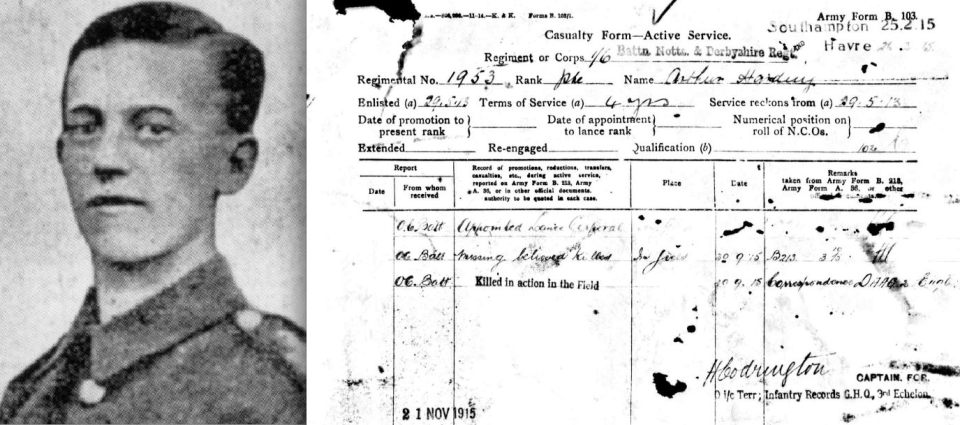
1437 Pte. Alfred Hollingshead is buried in Chester Farm (grave I G 17). A resident of Ashbourne, Alfred enlisted in May 1911 and served with “C” Company. He had previously been wounded at Kemmel on 19th May 1915. Commemorated with Honour on the Ashbourne War Memorial.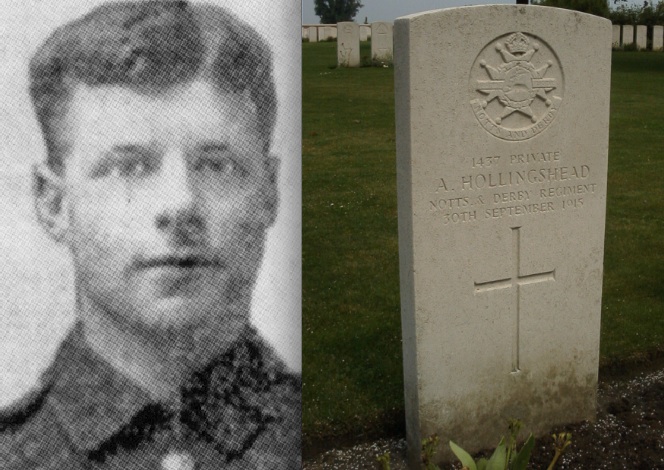
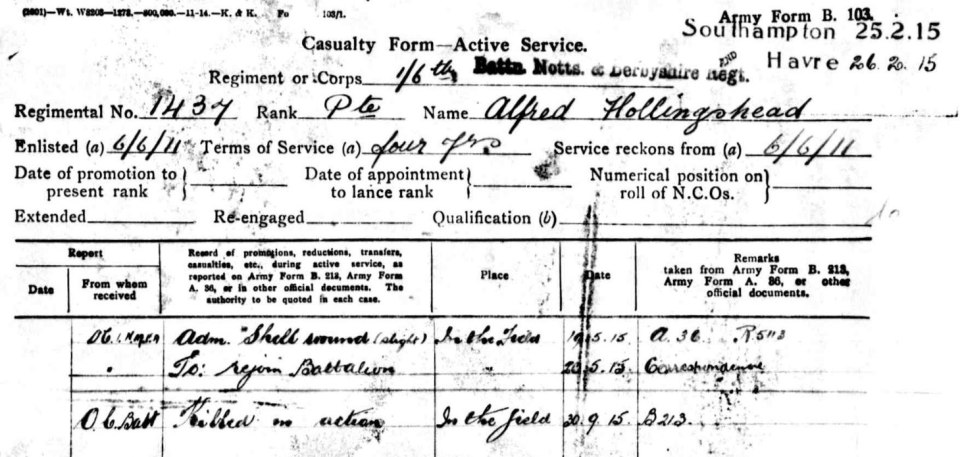
1785 Pte. Frederick Cecil Hooley aged 18 and is commemorated on Ypres Memorial. The son of Fred and Mary Elizabeth Hooley of 15 Cromford Rd., Wirksworth. Frederick enlisted in February 1913 and arrived in France on 28th February 1915. Prior to the War Frederick was a Bank Clerk and had been educated at Bingley Grammar School. Commemorated with Honour on the Wirksworth War Memorial.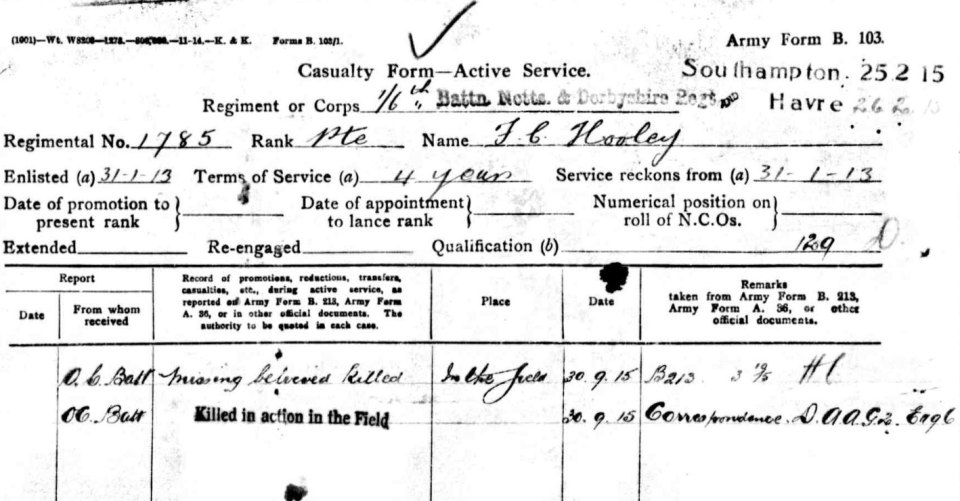
1892 Pte. George Partridge who is buried in Chester Farm (grave I B 3). A resident of Matlock, George enlisted in April 1913 and arrived in France on 28th February 1915. Commemorated with Honour on the Matlock War Memorial.
3561 Pte. Albert Roberts aged 20 and is commemorated on Ypres Memorial. The son of Joseph and Harriet Roberts of Parwich, Ashbourne. Albert enlisted in November 1914 and arrived in France on 26th June 1915. Commemorated with Honour on the Ashbourne War Memorial.
3159 Pte. Charles Roberts aged 22 and is commemorated on Ypres Memorial. The husband of Elizabeth Robinson (formerly Roberts) of Clarke’s Yard, King St., Clay Cross. Charles enlisted in October 1914 and arrived in France on 26th May 1915. Commemorated with Honour on the Clay Cross War Memorial.
1448 Sergt. William Albert Wibberley who is commemorated on Ypres Memorial. A resident of Ashbourne, William enlisted in June 1911 and arrived in France on 28th February 1915. Mentioned in dispatches on 22.9.15 for leading patrols at Kemmel and Sanctuary Wood. Commemorated with Honour on the Ashbourne War Memorial.
3550 Pte. James Wardle who is commemorated on Ypres Memorial. A resident of Ashbourne, James enlisted in November 1914 and arrived in France on 28th February 1915. Commemorated with Honour on the Ashbourne War Memorial.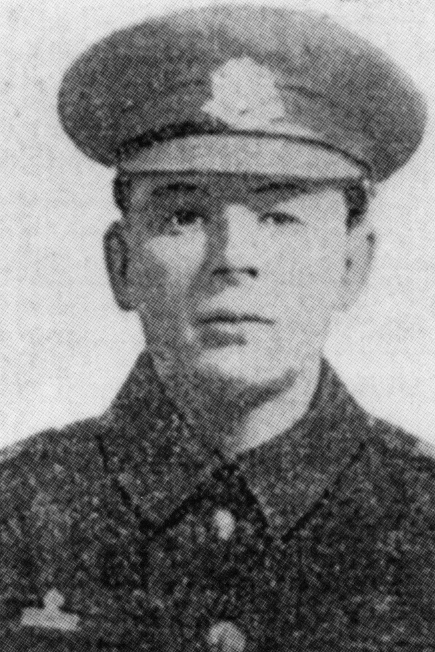
1667 Pte. Samuel Henry Yates who is commemorated on Ypres Memorial. A resident of Wormhill, Samuel enlisted in April 1912 and was an original member of “B” Company. He arrived in France on 28th February 1915. Commemorated with Honour on the Peak Dale War Memorial.
The 1/6th Battalion now prepared for a move to another sector and once again could reflect on a trench tour which had cost them many casualties, either killed or wounded. The Battalion History records that two Officers; Lieutenants William Brown and Lewis Dickenson, and 16 N.C.O.s and men were killed, whilst two Officers, Lieutenant D Storr-Fox and 2/Lt J.S Sampson and 46 other ranks were wounded and 12 men missing.
In total the Battalion had to date lost ?? men killed or died of wounds and ?? wounded. The Battalion had yet to take part in a major battle but the nature of the War meant that slowly, but inextricably, the pre-war Territorial spirit of the Battalion was being eroded.
Men of the 6/Sherwood Foresters who were killed or died of wounds during front line duty at Ypres
June to September 1915
(alphabetical order)
BENNETT, TOM EDGAR, Pte. 3287; k. in a. 28/06/1915 aged 32 and commemorated on Ypres Menin Gate. The Son of the late John and Constance Bennett he was a resident of Chesterfield. Tom enlisted on 26.10.15 and arrived in France on 28.2.15 where he served with D Company. He attended Nottingham University and became an articled pupil at the Electrical Works of the Borough of Chesterfield. Tom was originally buried in Armagh Wood by Major Hall but his bodied was not recovered after the War.
EVANS, RICHARD, Pte. 2030; d of w 04/07/1915 aged 25 and is buried in Bedford House No2 IV (grave B60). The son of Richard Evans and husband of Annie Crook (formerly Evans) of Manchester Rd., Chapel-en-le-Frith, Derbyshire. Richard enlisted in July 1913 and was an original member of “B” Company. He arrived in France on 28.2.15 and was orderly to Lieut. Joseph Tolsen.
FORD, JOSEPH, Pte. 2284; d of w 04/07/1915 aged 30 and buried in Bedford House No2 IV (grave B62). The son of Joseph and Margaret Ford of Chapel Milton, Chapel-en-le-Frith; husband of Edith Throniley Ford of Roe Buck Place, Chapel-en-le-Frith. Joseph enlisted in September 1914 and arrived in France on 28.2.15. He served with “B” Company and was also wounded on 16.6.15 at Kemmel. He was a native of Chinley and prior to the War he was employed at Messrs Froods.
GREATOREX, JAMES, Pte. 2290; d of w 04/07/1915 aged 18 and buried in Bedford House No2 IV (grave B65). Son of James and Elizabeth Greatorex of The Wash, Chapel-en-le-Frith. James enlisted in September 1914 and was a member of “B” Company.
HEATHER, PERCY, Pte. 1321; d of w 04/07/1915 and is buried in Bedford House No2 IV (grave B26). A resident of Milton near Chapel he had enlisted in January 1911 and was an original member of “B” Company. He had previously been wounded in the leg when on a working party carrying barbed wire to the trenches at Kemmel. Percy was one of four brothers who served in the War (one of whom had already been wounded).
LOMAS, GEORGE WILLIAM, L/Cpl. 3224; d of w 04/07/1915 aged 20 and is buried in Lijssenthoek Cemetery (grave III.D.7). The son of Mr and Mrs James Lomas. Born in Dove Holes he enlisted in October 1914 and arrived in France on 25.6.15.
- Commemorated with Honour on the Doves Holes War Memorial
LOWE, HORACE W., Pte. 3117; d of w 04/07/1915 aged 19 and is buried in Bedford House No2 IV (grave B64). The son of Mrs Elizabeth Lowe of Knabb House, Two Dales, Matlock. Horace enlisted in October 1914 and had only just arrived in France with a draft of reinforcements (26th June) when he was killed returning with a working party. In his last letter to his mother (dated 1st July) he had asked for a parcel of tea and sugar.
- Commemorated with Honour on the Darley Dale and Matlock War Memorials
MOSS, JOHN ROBERT, Pte. 2655; d of w 04/07/1915 and buried in Bedford House No2 IV (grave B59). Enlisted in October 1914 and arrived in France on 28th February 1915. He was a resident of Grassmore.
- Commemorated with Honour on the Grassmoor War Memorial
TURNER, SAMUEL, Pte. 1322; d of w 04/07/1915 aged 21 and is buried in Lijssenthoek Cemetery (III.D.6A). The son of John and Mary Turner of Tom Lane, Whaley Bridge. Samuel enlisted in January 1911 and was an original member of “B” Company. Prior to the War he lived at Combs and was employed at Messrs Froods. He was a well known local sprinter winning prizes in many local races.
MARKHAM, George H., Pte. 2213; d of w 11/07/1915 and buried in Etaples (grave II.A.19). George enlisted in May 1915 and arrived in France on 25.6.15. He served overseas with “A” Company. A resident of Gainsborough he had formerly served in the Lincolnshire Regt.
DEPLEDGE, HARRY, Pte. 1563; k in a 12/07/1915 age 20 and buried in Maple Copse – special memorial G19. Harry enlisted in 1912 and arrived in France on 28.2.15. A resident of Horwich End, Whaley Bridge, he was buried in a ‘little graveyard’ behind the trenches and a cross with an inscription place on his grave. Sergeant Jackson of No 7 Platoon, B (Chapel) Company wrote that he died at duty and did not suffer.
- Commemorated with Honour on the Whaley Bridge War Memorial
HALLAM, FRANK, Pte. 2142; k in a 22/07/1915 aged 19 and buried in Maple Copse – special memorial E23. The son of Sarah Lavinia Hallam of 32 Hillside Terrace, Mansfield Rd., Fairfield, Buxton. Frank enlisted in March 1914 and was a Battalion Drummer.
GENT, ALFRED, Corporal 1301; k in a 23/07/1915 and buried in Maple Copse – special memorial E15. Alfred was a resident of Chesterfield and enlisted in January 1911. He arrived in France on 28th February and served with “A” Company.
EYRE, WILLIAM, Pte. 2980; k in a 24/07/1915 and buried in Maple Copse – special memorial G24. William was a resident of North Wingfield and enlisted in October 1914. He arrived in France on 28th February 1915.
- Commemorated with Honour on the North Wingfield War Memorial
BUXTON, HAROLD, Pte. 2859; d of w 28/07/1915 aged 29 and buried in Boulogne Eastern Cemetery (grave VIII. B. 67). The husband of H Buxton of 19 Bridge St., New Tupton, Chesterfield. Harold enlisted in October 1914 and arrived in France on 28th February 1915.
CARTLEDGE, WILLIAM, Pte. 1575; k in a 28/07/1915 and is buried in Divisional Cemetery (grave F4). A resident of Monsal Dale (Litton) William enlisted in February 1912 aged 18. He was an original member of “B” Company and arrived in France on 28.2.15. Prior to the War William was a Quarryman.
READ, ARTHUR EDWARD, Pte. 894; k in a 29/07/1915 aged 25 and buried in Maple Copse – special memorial B18. The son of James Read of 3 Miller Avenue, Toronto West, Ontario and the late Sarah Read. Arthur was a native of Matlock Bank and enlisted in 1908.
- Commemorated with Honour on Matlock War Memorial
BARBER, JOHN, Pte. 1776; k in a 04/08/1915 aged 18 and buried in Maple Copse – special memorial J7. The son of John and Sarah Barber of 89 Bate Mill Row, Thornset, Birch Vale. John was a resident of Will Hey, New Mills and employed at Birch Vale Printworks. He enlisted in January 1913 aged 17 and was a member of the Regimental Band. He was an original member of “H” Company and arrived in France on 28th February 1915.
BIRKS, GEORGE EDWARD, Pte. 2838; d of w 05/08/1915 and buried in Lijssenthoek I.C.13A. A resident of Chesterfield, George enlisted in October 1914 aged 25 and arrived in France on 28.2.15. George was wounded in the head by shrapnel and died in the 28th Division Clearing station. Prior to the War he was a Miner.
- Commemorated with Honour on the Morton War Memorial
CROWDER, JOHN HENRY, Pte. 1652; died 08/08/1915 aged 21 and is buried in Hazebrouck (grave II.G.9). He was the son of John and Hannah Crowder of 6 Prospect Place, Newbold Rd., Chesterfield. John enlisted in April 1912 aged 18 and served with “A” Company. He arrived in France on 28th February but developed pleurisy and died in the 50th Casualty Clearing Station. Prior to the War he was a Gardner and employed by Proctors.
GUY, PERCY, Pte. 1811; d of w 08/08/1915 aged 19 and is buried in Le Treport (grave 1 G 7A). The son of William and Emma Guy of Brookfield House, Morton, near Alfreton. Percy enlisted in February 1913 and served with “D” Company.
- Commemorated with Honour on the Morton War Memorial
WOOLLEY, NORMAN, Pte. 1602; k in a 08/08/1915 and buried in Hooge Crater (grave IV.H.11). A resident of Brimington, Norman enlisted in 1912 and arrived in France on 28th February 1915.
- Commemorated with Honour on the Brimington War Memorial
SCHWARTZ, PERCY, Pte. 1861; k in a 10/08/1915 and commemorated on the Ypres Memorial. A resident of Eckington, Percy enlisted in April 1913 and arrived in France on 28th February 1915.
BROWN, FREDERICK, Pte. 1480; k in a 15/08/1915 and commemorated on the Ypres Memorial. A resident of Brimington, Frederick enlisted in September 1911 aged 17. He arrived in France on 28th February 1915. Prior to the War he was an engine driver.
- Commemorated with Honour on the Brimington War Memorial
FURNESS, WILLIAM EDWARD, Sergeant, 2365; k in a 15/08/1915 aged 31 and is commemorated on the Ypres Memorial. The Son of Mary Ann Furness of Berkshire House, Shirland St., Chesterfield and the late James Edward Furness. William enlisted in August 1914 and arrived in France on 28th February 1915 where he served with “A” Company.
MORGAN, FRANK, Pte. 1689; k in a 15/08/1915 and is commemorated on the Ypres Memorial. A resident of Brimington, Frank enlisted in April 1912 and served with A Company. He arrived in France on 28th February 1915 and had previously been wounded on 4th July 1915.
REDFERN, JOHN THOMAS, Pte. 2936; k in a 15/08/1915 and is commemorated on the Ypres Memorial. The son of Frederick Redfern of 99 Barker Lane, Brampton, Chesterfield. John enlisted in October 1914 and arrived in France on 28th February 1915.
- Commemorated with Honour on the Brampton War Memorial
RICHARDSON, ALBERT, Pte. 1752; k in a 15/08/1915 and is commemorated on the Ypres Memorial. A resident of Chinley he had just celebrated his birthday the day before he was killed. He was a prominent harrier and took great interest in football, scouting and athletics. Two brothers also served on active duty; Gunner J Richardson, R.F.A., and Driver William Richardson, A.S.C. Albert enlisted in October 1912 and was an original member of “B” Company.
GASSER, ERNEST, Pte. 3460; d of w 22/08/1915 aged 35 and is buried in Lijssenthoek Cemetery (grave III.C.33A). The son of James and Sarah Gasser of 44 Speedwell Terrace, Staveley and Husband of Bessie Humberstone (former]y Gasser) of 59 Cemetery Rd., Woodlands, Doncaster. Ernest enlisted in October 1914 and arrived in France on 28th February 1915.
- Commemorated with Honour on the Staveley War Memorial
WHITE, PETER, L/Cpl. 1410; d of w 24/08/1915 aged 22 and is buried in ABBEVILLE COMMUNAL CEMETERY (grave II.C.8). The son of George and P White of Clay Cross, Chesterfield. Peter enlisted in May 1911 and served with “G” Company. He arrived in France on 28th February 1915 and died from blood poisoning due to a bullet wound.
BOOTH, MATTHEW, Pte. 1964; d of w 26/08/1915 aged 27 and is buried in Lijssenthoek Cemetery (grave III.C.30A). The son of Mr and Mrs H Booth of 6 Torrs Yard, Wirksworth, Derbyshire. Matthew enlisted in June 1913 and served with “G” Company. He arrived in France on 28th February 1915 and died in the 28 Division CCS from a shell wound to the head. Prior to the War he was a Quarryman.
- Commemorated with Honour on the Wirksworth War Memorial
WHITTAKER, CHARLES THOMAS, Pte. 2007; d of w 08/09/1915 aged 19 and is buried in Spoilbank Cemetery I H 15. Son of Sarah Ann Bingham of 80 High St., Tibshelf. Charles enlisted in June 1913 and arrived in France on 28th February 1915.
- Commemorated with Honour on the Tibshelf War Memorial
BATES, WALTER, Pte. 3161; k in a 17/09/1915 and is buried in Chester Farm Cemetery (grave I B 7). A resident of Clay Cross, Walter enlisted in October 1914 aged 29 and arrived in France on 28th February 1915. Prior to the War he was a Miner.
- Commemorated with Honour on the Clay Cross War Memorial
CLARKE, WILLIAM, Pte. 1900; k in a 19/09/1915 aged 21 and is buried in Chester Farm (grave I C 4). The son of Samuel and Florence Clarke of 28 Central Terrace, Chesterfield. William enlisted in May 1913 aged 18 and arrived in France on 28th February 1915. Prior to the War he was a machine hand.
ELLIS, RALPH, Pte. 2097; k in a 19/09/1915 aged 19 and is buried in Chester Farm I C 5. Son of Sarah Jane Ellis of 9 Brockwell Terrace, Chesterfield. Ralph enlisted in January 1914 and arrived in France on 28th February 1915.
McBRIDE, JOHN, Sergeant, 2344; k in a 19/09/1915 aged 37 and is buried in Chester Farm I B 6. The husband of Maria McBride of 80 Spital Lane, Chesterfield. John was born in Letterkenny, Co. Donegal and served in the South African War of 1899-1902 (QSA bars South Africa 1901, Transvaal, Orange Free State, Cape Colony) and also spent four years in India with Royal Garrison Artillery. John enlisted in the 1/6th Battn in August 1914 and arrived in France on 28th February 1915. He served with “A” Company and was wounded on 11th May 1915 at Kemmel. He was killed in action by a direct hit from a German shell when tending the wounded.
- Commemorated with Honour on the Spital War Memorial
ROBERTS, JOHN HENRY, Pte. 1890; k in a 19/09/1915 aged 23 and is buried in Chester Farm I C 6. The son of Noah and Lydia Roberts of 23 Queen St., Mosborough, Sheffield. John was a resident of Staveley and enlisted in April 1913.
BAGSHAW, HUGH, Pte. 2881; k in a 21/09/1915 aged 17 and is buried in Chester Farm I B 5. The son of Harriet Bagshaw of 5 Railway Cottages, Whaley Bridge, Stockport. A resident of Fernilee, Hugh enlisted in October 1914 aged 18. He arrived in France on 28th June 1915 and was posted to No.2 Entrenching Battn. He joined the 1/6th Battn in the field on 17th August 1915 and was killed in action a month later.
- Commemorated with Honour on the Whaley Bridge War Memorial
BROWN, WILLIAM LEONARD, 2nd Lt; d of w 25/09/1915 aged 23 and buried in Reninghelst Churchyard Extension. The son of Major Abraham and Lucie Brown of 20 Hardwick St., Buxton, Derbyshire. A Solicitor by profession, William arrived in France on 16.7.15. William’s Brother Cecil also held a Commission with the 1/6th Battn and was killed in action on 23.54.17.
- Commemorated with Honour on the Buxton War Memorial
KERSEY, JOHN AUBREY CYRIL, Lance Corporal, 1456; d of w 26/09/1915 aged 20 and buried in St. Marie Cemetery Div (grave 19. I. 9. The son of John and Isabella Kersey of 1 King’s Terrace, Smedley St. Matlock. John enlisted in June 1911 and arrived in France on 28th February 1915.
- Commemorated with Honour on the Matlock War Memorial
BAGSHAW, LEONARD, Pte. 1557; died 29/09/1915 aged 24 and is buried in Fernilee Methodist Church. The son of Charles and Phoebe Bagshaw, of 74 Macclesfield Rd., Whaley Bridge. Leonard enlisted in January 1912 aged 21 and served with “H” Company. He returned to England on the 20th May 1915 and died of a brain tumour in the Northern General Hospital at Sheffield. Prior to the War Leonard was a Collier at Shallowcross mine in Whaley Bridge
- Commemorated with Honour on the Whaley Bridge War Memorial
BRADLEY, JAMES, Pte. 1812; k in a 30/09/1915 aged 18 and is commemorated on Ypres Memorial. The son of Henry and Alice Bradley of Wall Ash, Mayfield. James enlisted in February 1913 aged 18 and served with “C” Company. He arrived in France on 28th February 1915 and was missing believed killed when the Germans exploded a mine under the trenches at the Bluff.
CARTER, CHARLES S., Pte. 2524; k in a 30/09/1915 aged 19 and commemorated on Ypres Memorial. The son of Edward and Martha Carter of Market Place, Ashbourne. Charles enlisted in October 1914 aged 19 and served with “C” Company. His brother 3541 Thomas Carter was killed in action during the Battle of Loos on 15/10/15.
CHAPMAN, HAROLD, Pte. 2152; k in a 30/09/1915 aged 21 and is buried in Chester Farm (grave I B 4). The son of James and Sarah Chapman of Tideswell. Harold enlisted in March 1914 aged 19 and served with “D” Company. Prior to the War he was a grocer.
- Commemorated with Honour on the Tideswall War Memorial
DARCY, THOMAS, Pte. 2276; k in a 30/09/1915 and is buried in Chester Farm (grave I B 2). Thomas was born in Kilkenny and enlisted at Chesterfield in September 1914. He arrived in France on 28th February 1915.
GOODWIN, OSCAR F., Pte. 2288; k in a 30/09/1915 and is commemorated on Ypres Memorial. A resident of Buxton, Oscar enlisted in September 1914 and arrived in France on 28th February 1915.
- Commemorated with Honour on the Buxton War Memorial
DICKINSON, LEWIS GEORGE, 2/Lt; k in a 30/09/1915 aged 36 and is buried in Spoilbank Cemetery (grave I G 18). The son of Frederick George and Ann Jemima Dickinson he was born in Sheffield. At the time of his death Lewis was serving with “C” Company but had previously been the Company Quarter Master Sergeant of “D” Company. He had won the Bisley Jubilee Badge of the King in 1909 and had been awarded the Territorial 12 year Efficiency badge.
- Commemorated with Honour on the Matlock and Matlock Bath War Memorials
HARDING, ARTHUR, L/Corporal, 1953; k in a 30/09/1915 aged 21 and is commemorated on Ypres Memorial. The son of James and Alice Harding, of Compton St., Ashbourne. Arthur enlisted in May 1913 and arrived in France on 28th February 1915.
- Commemorated with Honour on the Ashbourne War Memorial
HOLLINGSHEAD, ALFRED, Pte. 1437; k in a 30/09/1915 and is buried in Chester Farm (grave I G 17). A resident of Ashbourne, Alfred enlisted in May 1911 and served with “C” Company. He had previously been wounded at Kemmel on 19th May 1915.
- Commemorated with Honour on the Ashbourne War Memorial
HOOLEY, FREDERICK CECIL, Pte. 1785; k in a 30/09/1915 aged 18 and is commemorated on Ypres Memorial. The son of Fred and Mary Elizabeth Hooley of 15 Cromford Rd., Wirksworth. Frederick enlisted in February 1913 and arrived in France on 28th February 1915. Prior to the War Frederick was a Bank Clerk and had been educated at Bingley Grammar School.
- Commemorated with Honour on the Wirksworth War Memorial
PARTRIDGE, GEORGE, Pte. 1892; k in a 30/09/1915 and is buried in Chester Farm (grave I B 3). A resident of Matlock, George enlisted in April 1913 and arrived in France on 28th February 1915.
- Commemorated with Honour on the Matlock War Memorial
ROBERTS, ALBERT, Pte. 3561; k in a 30/09/1915 aged 20 and is commemorated on Ypres Memorial. The son of Joseph and Harriet Roberts of Parwich, Ashbourne. Albert enlisted in November 1914 and arrived in France on 26th June 1915.
- Commemorated with Honour on the Ashbourne War Memorial
ROBERTS, CHARLES, Pte. 3159; k in a 30/09/1915 aged 22 and is commemorated on Ypres Memorial. The husband of Elizabeth Robinson (formerly Roberts) of Clarke’s Yard, King St., Clay Cross. Charles enlisted in October 1914 and arrived in France on 26th May 1915.
- Commemorated with Honour on the Clay Cross War Memorial
WIBBERLEY, WILLIAM ALBERT, Sergeant, 1448; k in a 30/09/1915 and is commemorated on Ypres Memorial. A resident of Ashbourne, William enlisted in June 1911 and arrived in France on 28th February 1915. Mentioned in dispatches on 22.9.15 for leading patrols at Kemmel and Sanctuary Wood.
- Commemorated with Honour on the Ashbourne War Memorial
WARDLE, JAMES, Pte. 3550; k in a 30/09/1915 and is commemorated on Ypres Memorial. A resident of Ashbourne, James enlisted in November 1914 and arrived in France on 28th February 1915.
- Commemorated with Honour on the Ashbourne War Memorial
YATES, SAMUEL HENRY, Pte. 1667; k in a 30/09/1915 and is commemorated on Ypres Memorial. A resident of Wormhill, Samuel enlisted in April 1912 and was an original member of “B” Company. He arrived in France on 28th February 1915.
- Commemorated with Honour on the Peak Dale War Memorial
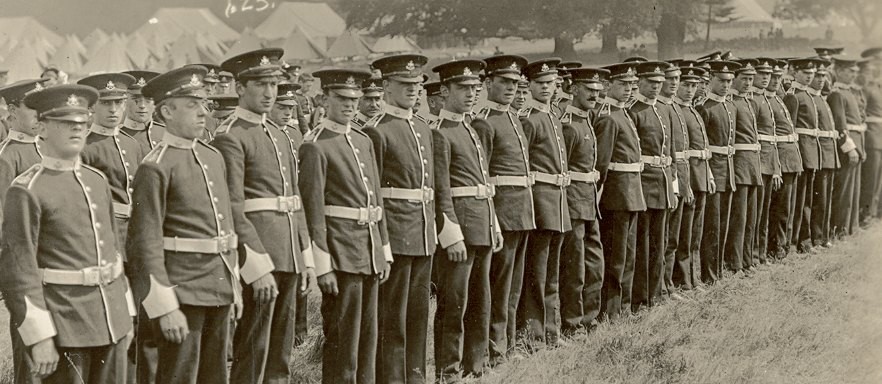
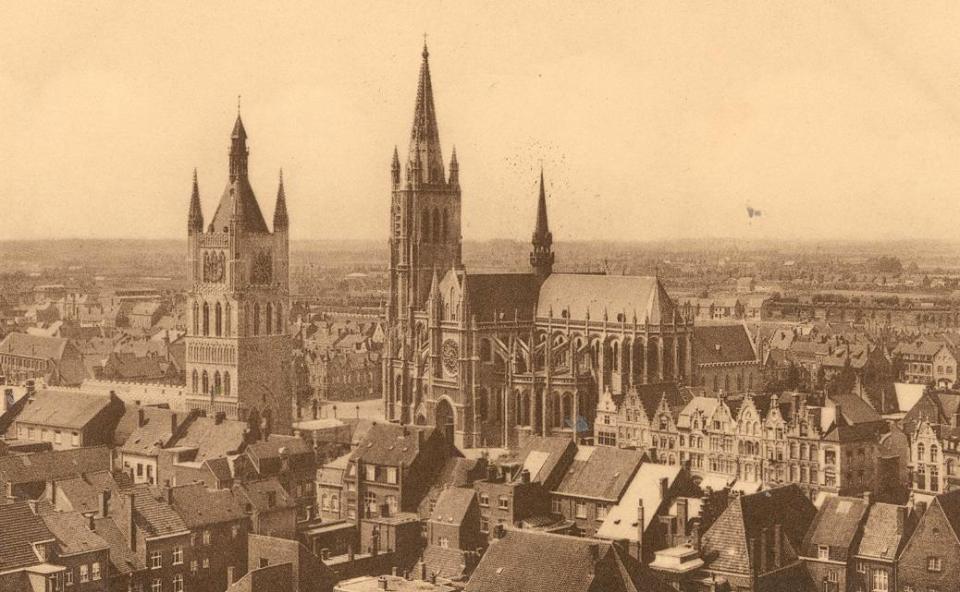
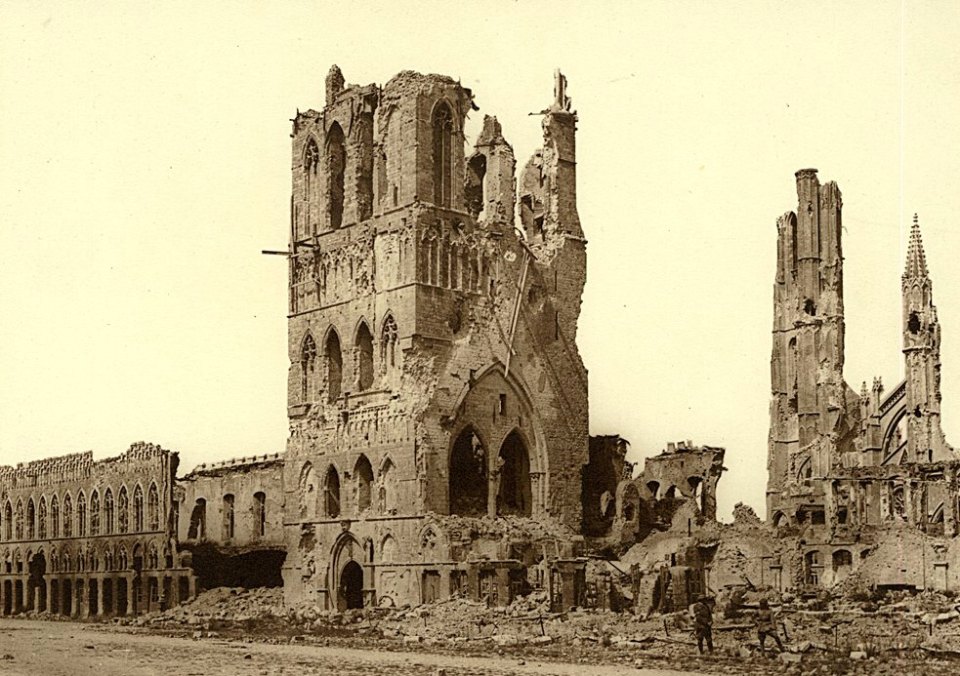


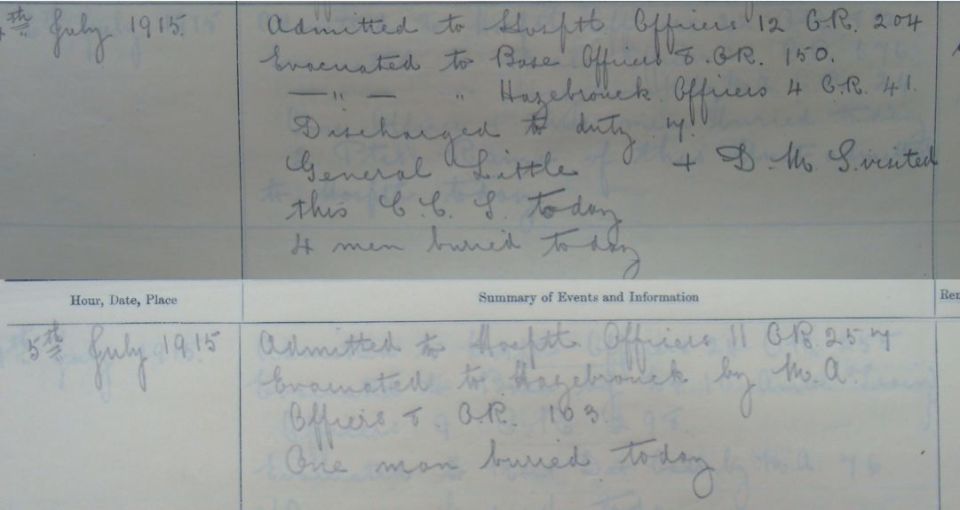
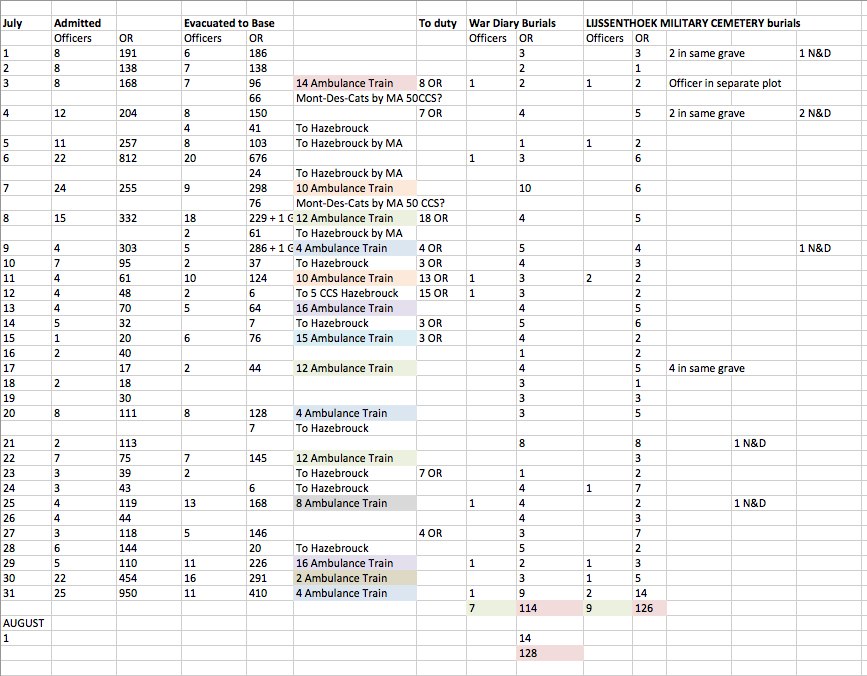





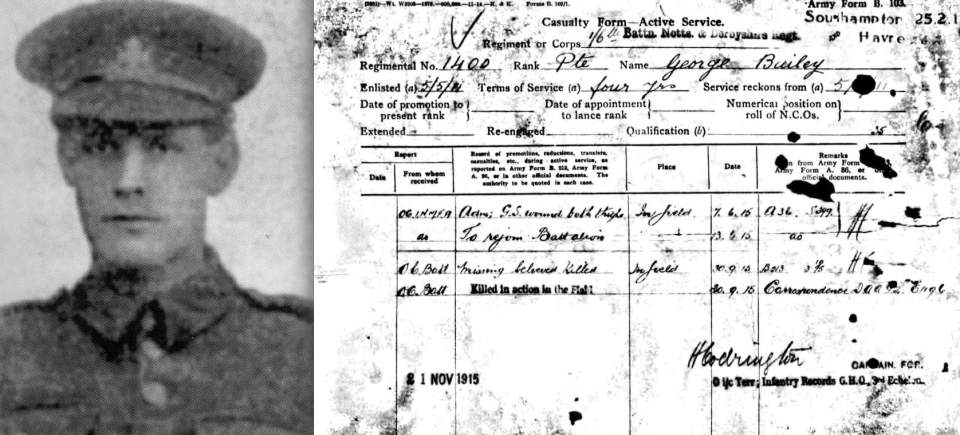
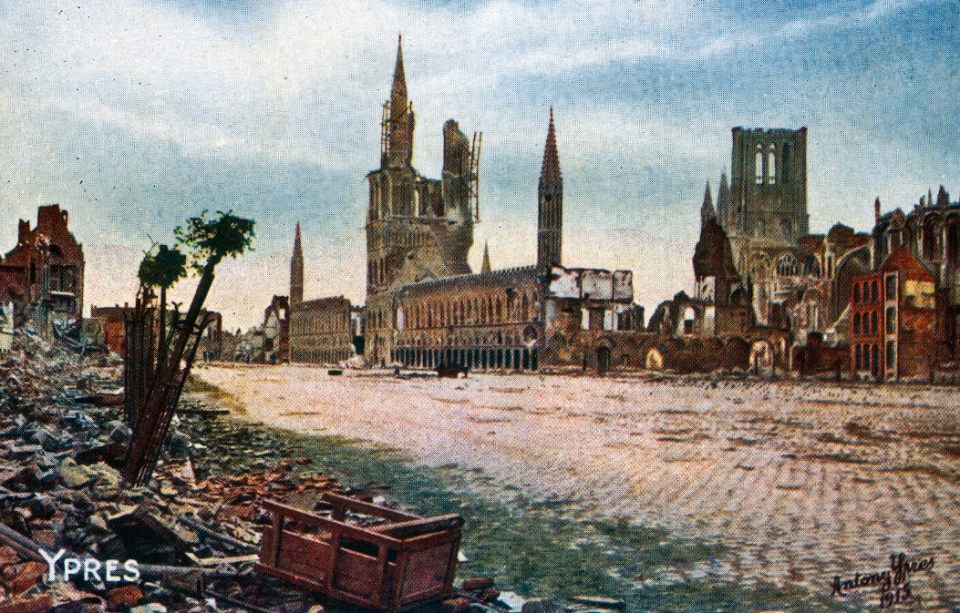
Excellent blog, thanks.
https://www.facebook.com/FifthLincs
Thanks Steve – much appreciated
hi having tried to search quite a bit, to try and find a photo of my dear uncle who .gave his life in the first war Reginald Downham who has no know grave, but is at Ypress arch.I wonder if you can help. I myself at 80 in July and I always had this wish to see what he looked like but have had no luck.
Thank you for the above work it is wonderful thank you once again
John R Downham Nephew of the late Pte Reginald Downham
Dear John. Thanks for your comment and sorry for delay in replying. I’m not aware of any photo of Reginald. I might be worth contacting the Regimental Archivist. best wishes Mike
Hi my partner is also related to Reginald Downham and he has a picture of him if you have still not seen a picture of him I am sure my partner would be only too pleased to make your wish come true.
So many lives loss. My grandfather was in Sherwood Foresters I’ve been told, he came back home.
I donr know what unit he was in, I have a photo of him with his regiment that’s all I have
Evening Julie, yes a terrible waste. Please let me know his name and where he was from, and email a copy of the photo to me [mike.briggs1910@gmail.com] and I’ll see if I can find out for you, cheers Mike
great blog thank you,very interesting to read about my ancestor john taylor who was wounded in ypres,like many others im on the look out for his photo,if you have any pointers on places to search?
Hi Joe
Glad you like it. This would be 11 John Taylor from Wirksworth? I would try the local library to see if there are photos printed in the local paper at the time. Prior to the War he served with E Company and would have been present in this group photo
https://derbyshireterritorials.wordpress.com/nominal-role/e-wirksworth-and-matlock-company/
cheers
Mike
thanks for your help mike,yes thats him he was originaly from leicester and served in the tigers i think before later moving to derbyshire,i will check the photo now as he would have been into his 40s by that stage so i might spot him,thanks again ill be following the blog and twitter from now on.
I’m looking to go back to Llissenthoek Cemetery in August 2018 and I am trying to find where Maple Copse is on a map of today so I can look out for it on the way. I believe the last whereabouts of my Great Uncle Walter Speight in 1917 was in the Assembly Trench “St Peters Street”
I believe it is in this area where the Sherwood’s were years previously. Any Ideas? Regards John Wood.
Thank you for all this information. Idwal Davies was an officer who convalesced at Polesden Lacey NT after his injuries.
I believe that Lieut. Arthur Frank London of the Notts and Derbyshires was also injured at this time. He was also at Polesden recovering from May 8th – October 14th. Do you have any information on him please?
Hi Janet
Thanks for message – let me check out Arthur London
cheers
Mike
Thank you Mike
What an amazing Site.. found my great uncle who died while tunneling… Body not recovered.. many thanks…
Thanks Jackie – much appreciated.
Pingback: William Lyons from Buxton – ‘the man that got lost’ | Derbyshire Territorials in the Great War
hi there,a fantastic site and a lot of work and time has gone into this which we all appreciate, thankyou,
we have recently been doing our family tree and found out our great great grandad was killed at ypres, on Saturday 24th July 1915
1/6th Bn. Private, 2980, William. Eyre, we have seen lots of pics on here of the men, and was wondering if u have any pics of him for us to see what he looked like, or if u have any additional information on him or about his journey or any links to info, we would greatly appreciate it thank you so much, yvonne broomhall.
Hi Yvonne – thanks you & really glad you like the site – the lads deserve to be remembered. Unfortunately I don’t have a picture, but William’s service record is available on ancestry and includes a copy of a hand written letter sent from his wife Harriet thanking the War Office for returning his effects. I can email them if you let me have an email address, thanks Mike.
Thanks to your site I was able to locate a photo of a distant cousin and to locate the place where he went missing – Germans activated an explosion under a trench he was in and buried never to be found — No.1953 L/Cpl Arthur Harding
Thanks Malcolm very happy to hear that – glad the site was of use – good to remember those guy, cheers Mike
Pingback: 2190 Pte Walter Edward Lamb from Chapel-en-le-Frith | Derbyshire Territorials in the Great War
Pingback: 1365 Pte Benjamin James Savage | Derbyshire Territorials in the Great War